Having been to nearly every island in the Caribbean, it was time for a new experience. Some place completely different and seemingly exotic, a place where the homogenization of islands and culture, due to the cruise ship industry and easy travel from the US, had not yet had its affects. Crossing off sailing destinations in the book, 50 Places to Sail Before You Die by Chris Santella (I’ve completed several, thanks mostly to having owned a catamaran in BVI), Thailand was next on the list.
Beginning in Bangkok the first three days allowed us to see the city and recoup from the flight. We then flew to Phuket to sail around the islands in the Andaman Sea and later headed back to Phuket after seven days on a private catamaran. Finally, we flew back to Bangkok for a night to prepare for an early flight back home. Anyone who has traveled that far can tell you, frankly, the flight brutal. Truthfully, I found it to be worse coming home and it takes less time. It’s worth every ounce of misery you experience, though.
Our tour guide was quick to tell us, “Thailand has three seasons: hot, hotter and hottest.” As someone who loves the heat and was born and raised in The South, I can tell you it was the hottest I’ve ever been in my life. There is no air conditioning in the temples, markets and some restaurants.
Thailand is just like you see it in the movies, and without sounding like a cliche, it was quite like arriving on a James Bond set when we landed. Like many large cities, Bangkok is polluted, poor, and what stood out most initially is there are wires everywhere. I don’t mean just a couple hanging from the poles like in the US, I mean everywhere. Electric, telephone, cable tv, internet wires and more are exposed and running from pole to pole above the shops. A friend from Thailand said the government doesn’t regulate the wiring at all. Unfortunately, it’s one of the things that makes the city look so bad visually. He also mentioned there is no Health Department or Department of Agriculture monitoring street food vendors. And when I say street food, I don’t mean a few hot dog stands here and there, like you see on street corners in NYC, I mean more street food carts than brick and mortar restaurants. More on that later. Did I mention the traffic is horrendous and people drive like they have a death wish? The tuk-tuks buzz in and out of traffic, and surprisingly, there aren’t more accidents. It is loud, busy, and frantic, but underneath all the chaos, Bangkok is colorful, exciting, fast, mysterious, and an insanely intriguing.
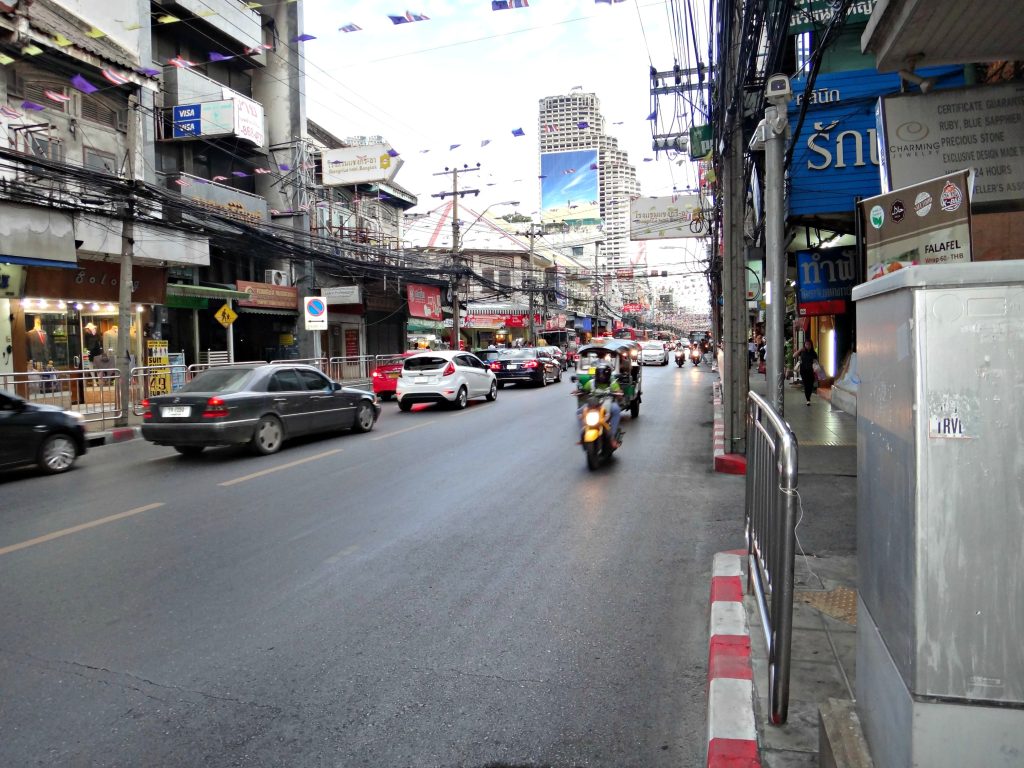
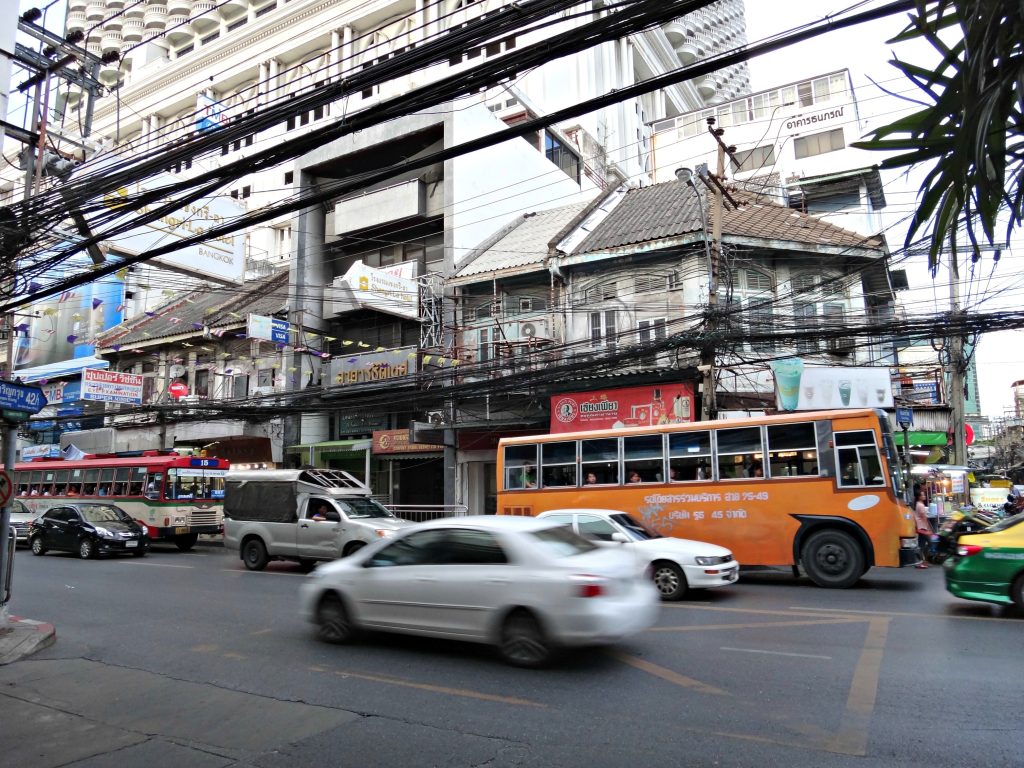
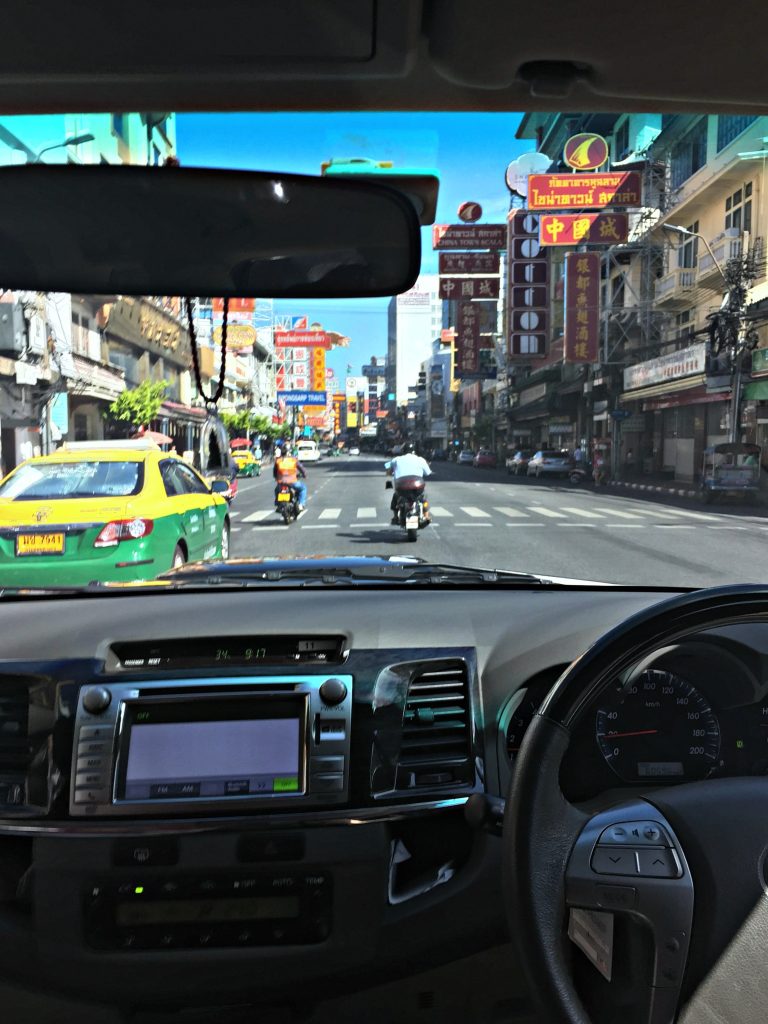
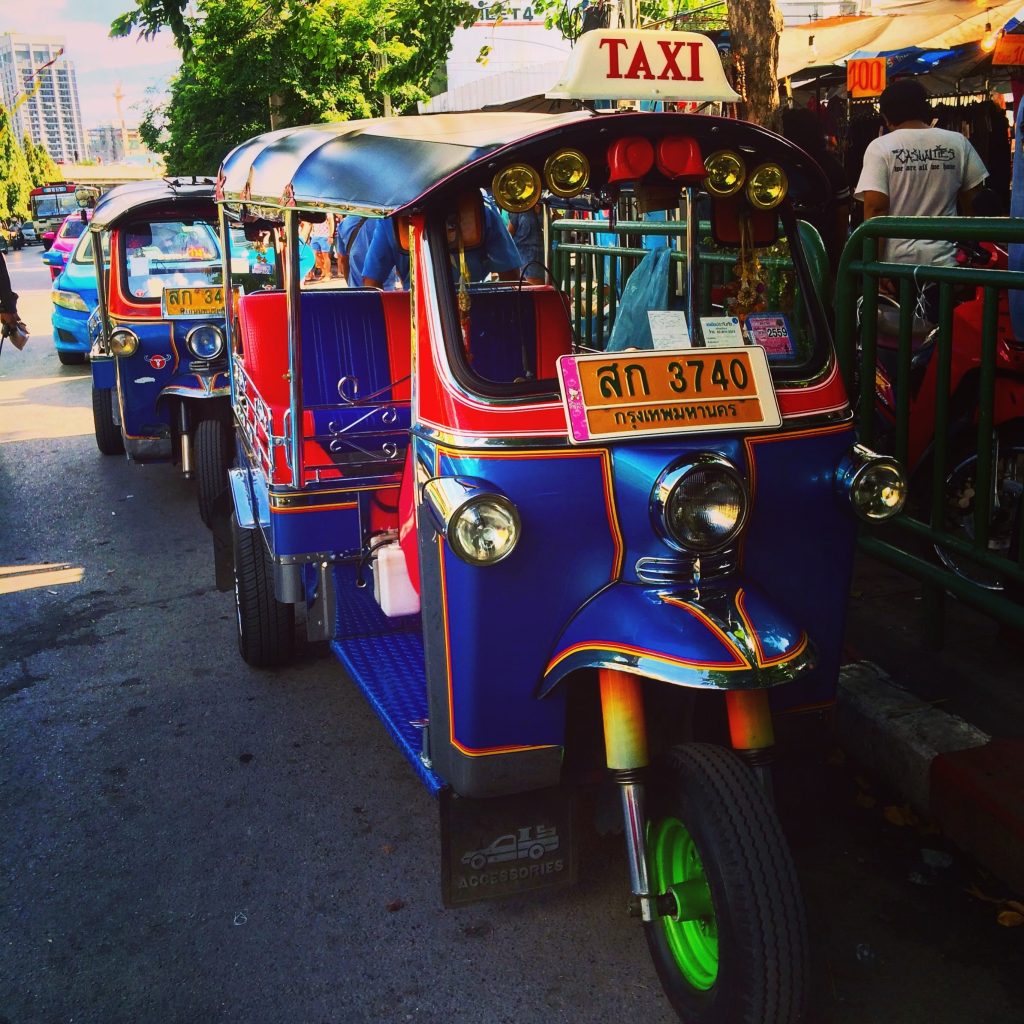
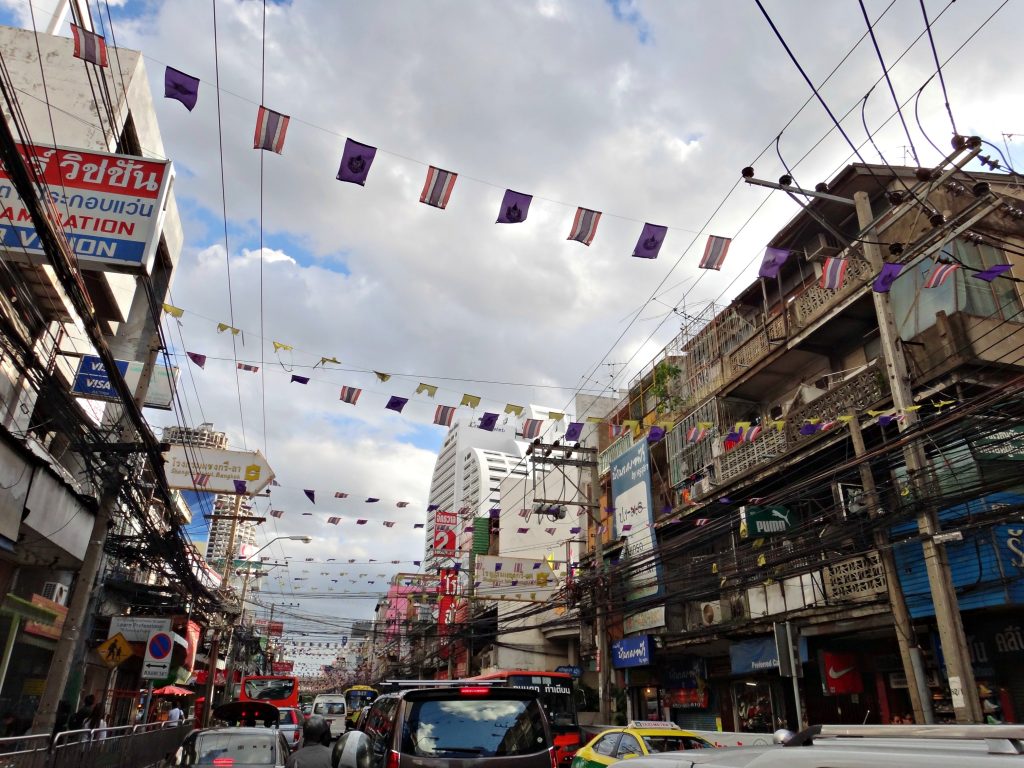
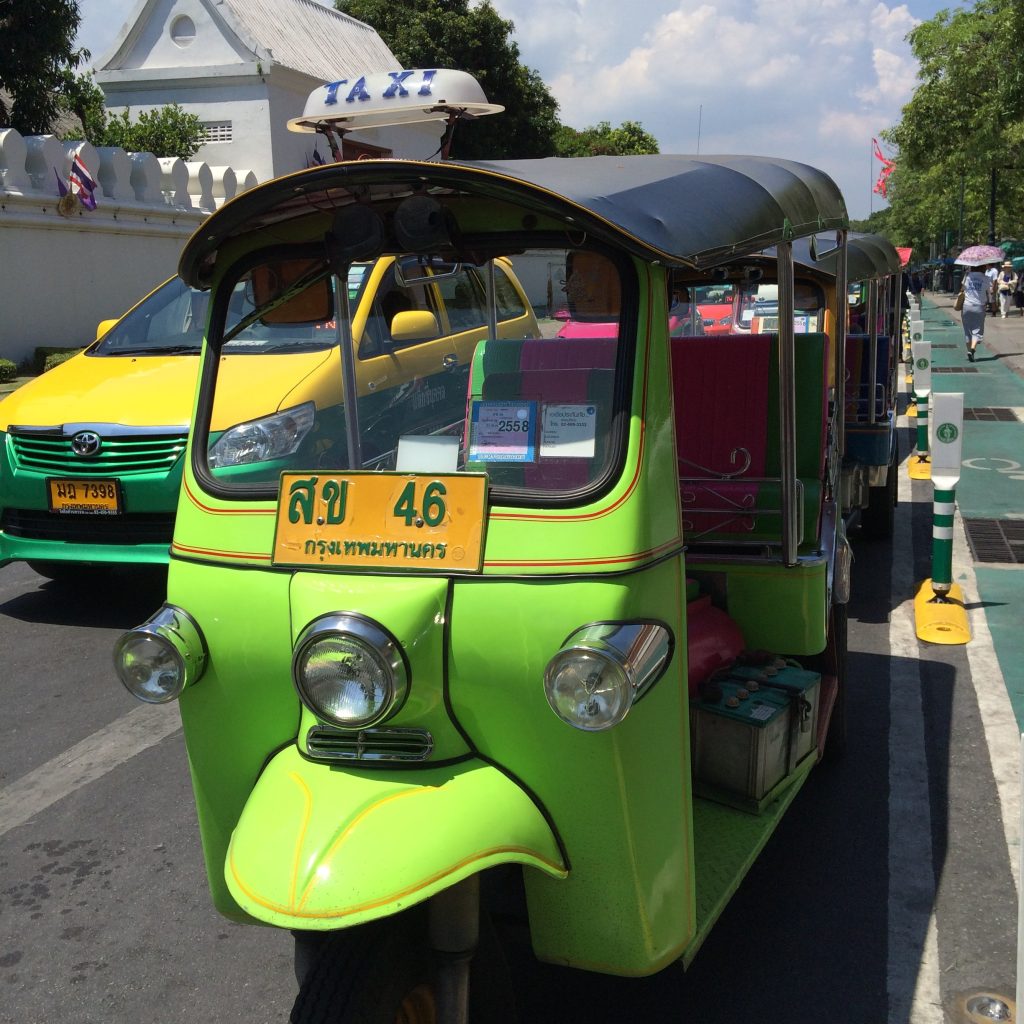
We arrived at night which was great, because all you want to do when you land is find your room, stretch out in your bed, and sleep off that flight after being crammed in a seat that long. Of course we mustered up the energy to go to the bar and have a drink and get our first glimpse of the Chao Praya River under the stars before heading up to our rooms. I love the greeting and bowing of the Thai people. Hands are dirty and so many people don’t wash after using the restroom or coughing and sneezing. The bow with hands in prayer seems like such a display of respect, whereas the Western form of greeting, the handshake, seems so much more casual.
At first morning light, the view of the river outside our room gave me such relief. After months and months of listening to worried friends and family who feared for our safety for some reason, and although I wasn’t worried about the trip, when I looked out the window, I felt comforted and relieved. Up and down the river, business was going on as usual, much like it does here in the States. I could see Thai boats carrying people to work at the hotels lining the river and many other unknown places. Everything seemed perfectly normal. Under the surface, like many other places, Bangkok has its underground dealings, popular tourist scams, and yes, many of the other things you’ve undoubtedly heard about the country. Don’t let any of that stop you. A great guide, a nice hotel and a little research prior to your trip, and you’ll be safe and know what to avoid. The other plus? Thailand is an incredible value for the dollar.
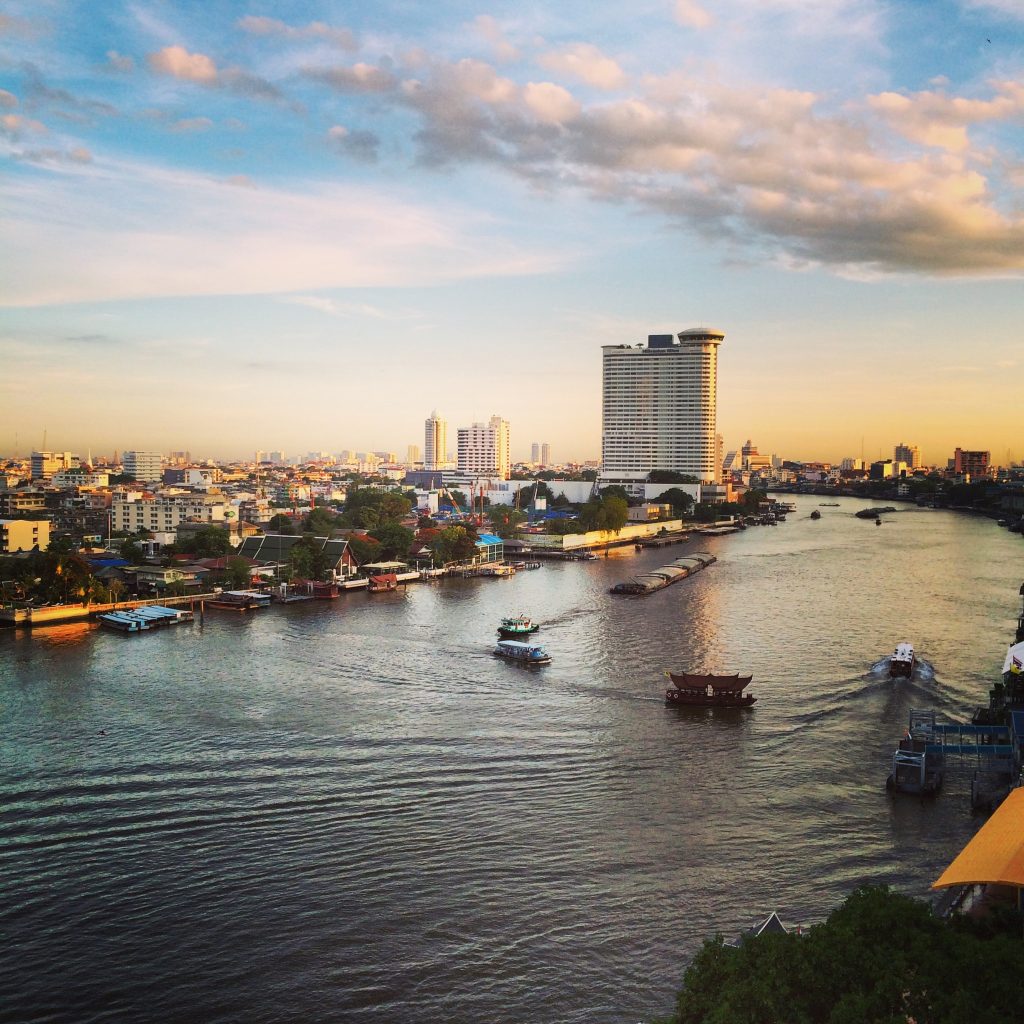
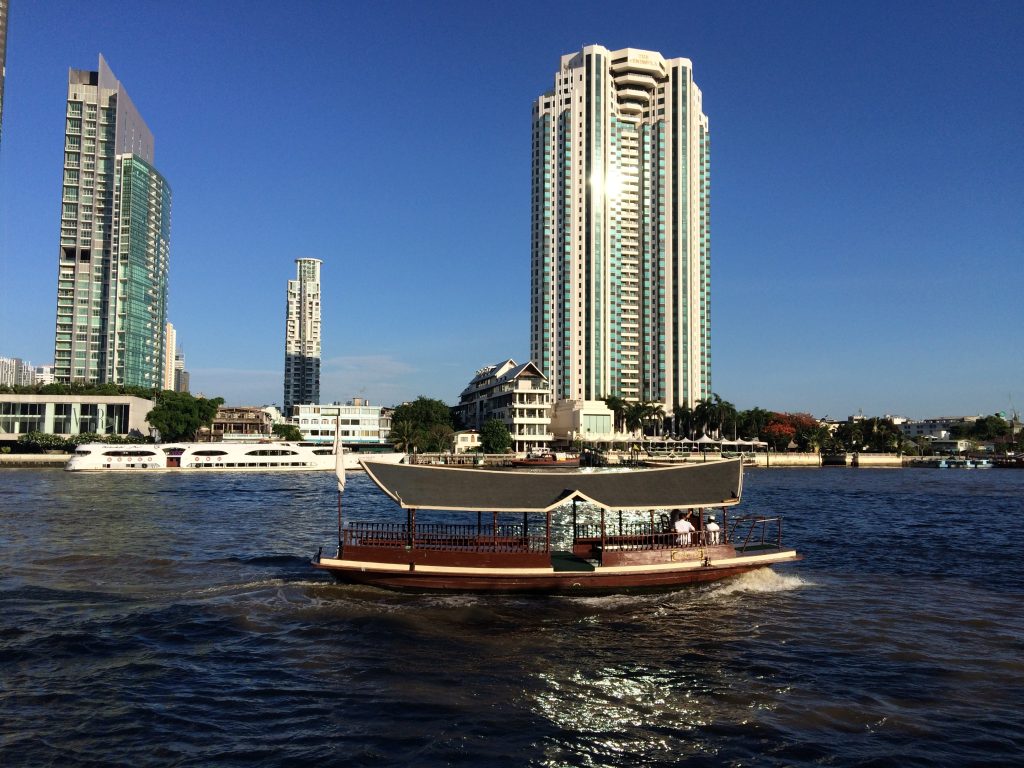
Shangri-La Hotel
We stayed at the Shangri-La which couldn’t have a been a better property. It was situated right on the river and centrally located to everything we had planned. After a mixed breakfast, representing cuisine from all cultures, we met my friend’s family in the lobby of the hotel. Since Thailand sees visitors from China, India and other surrounding places, the breakfast was separated by region and nationality and even included an American cuisine section. We sampled foods from many of the surrounding regions.
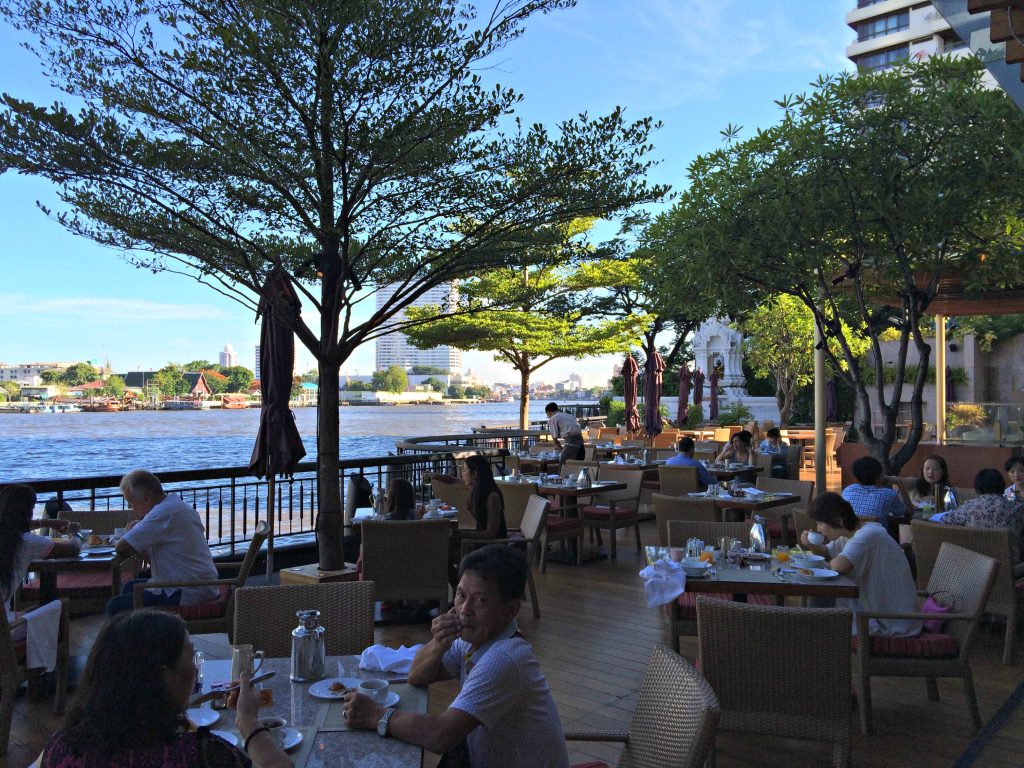
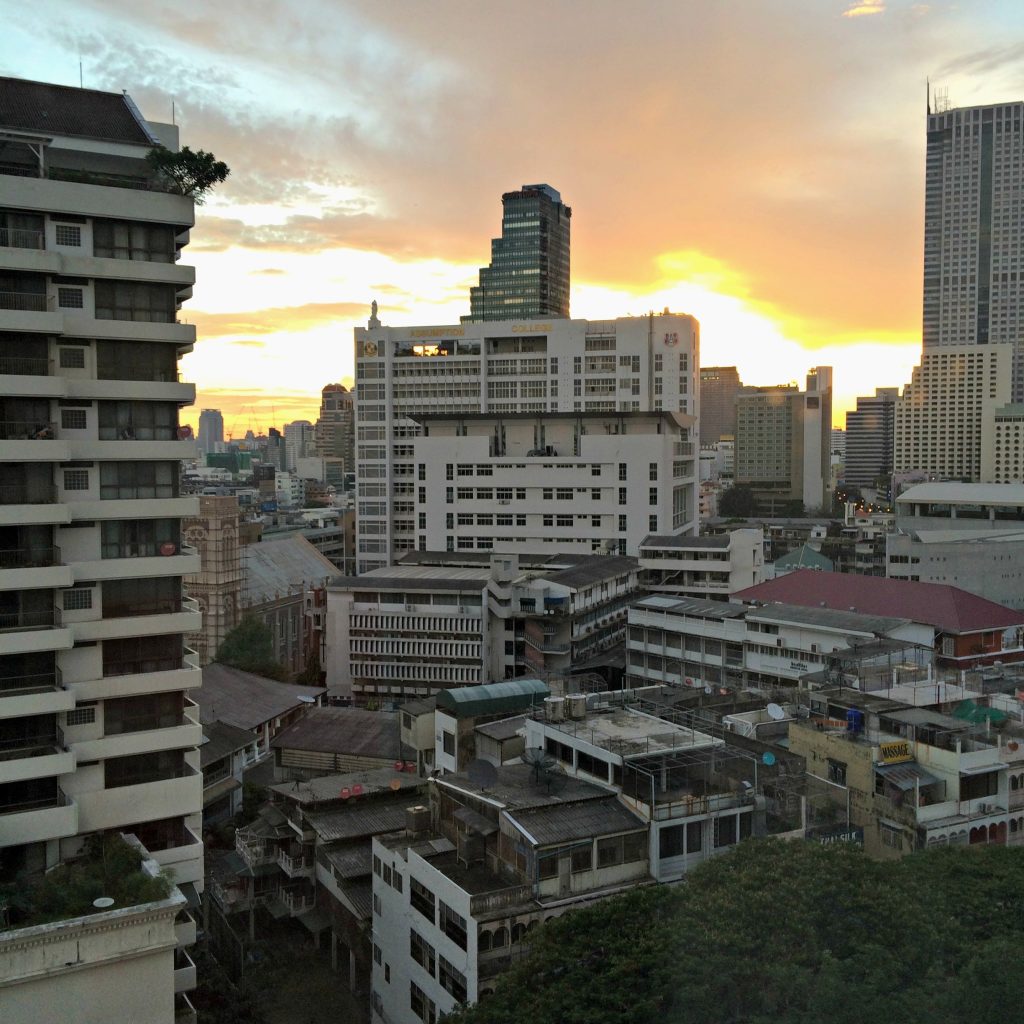
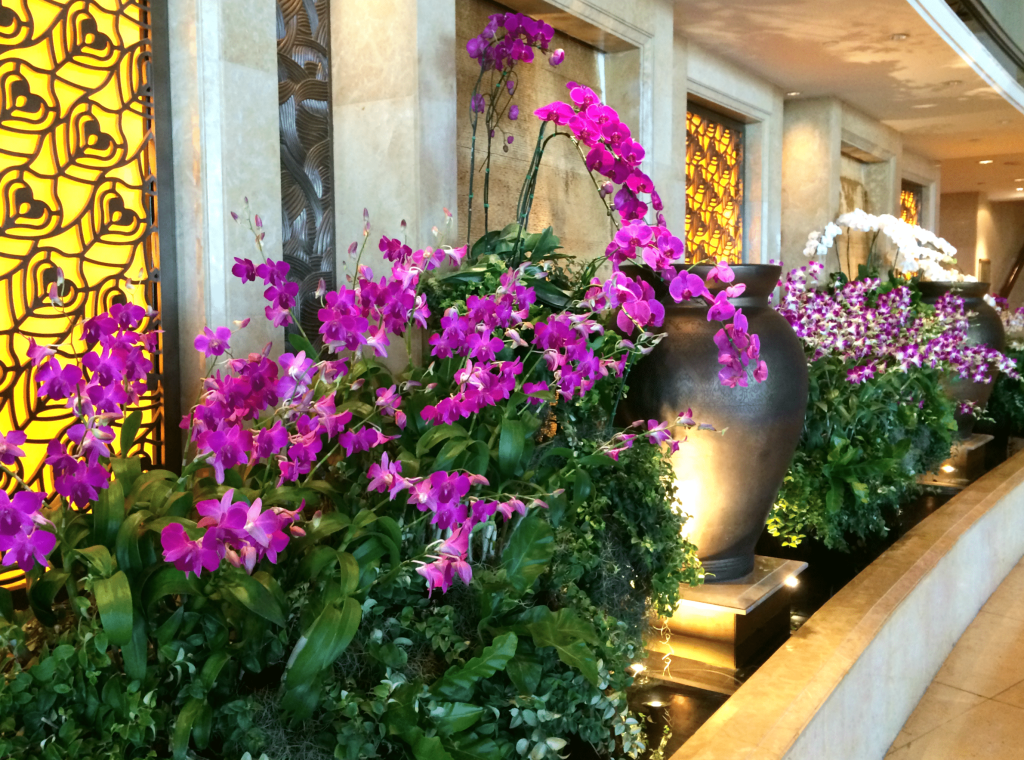
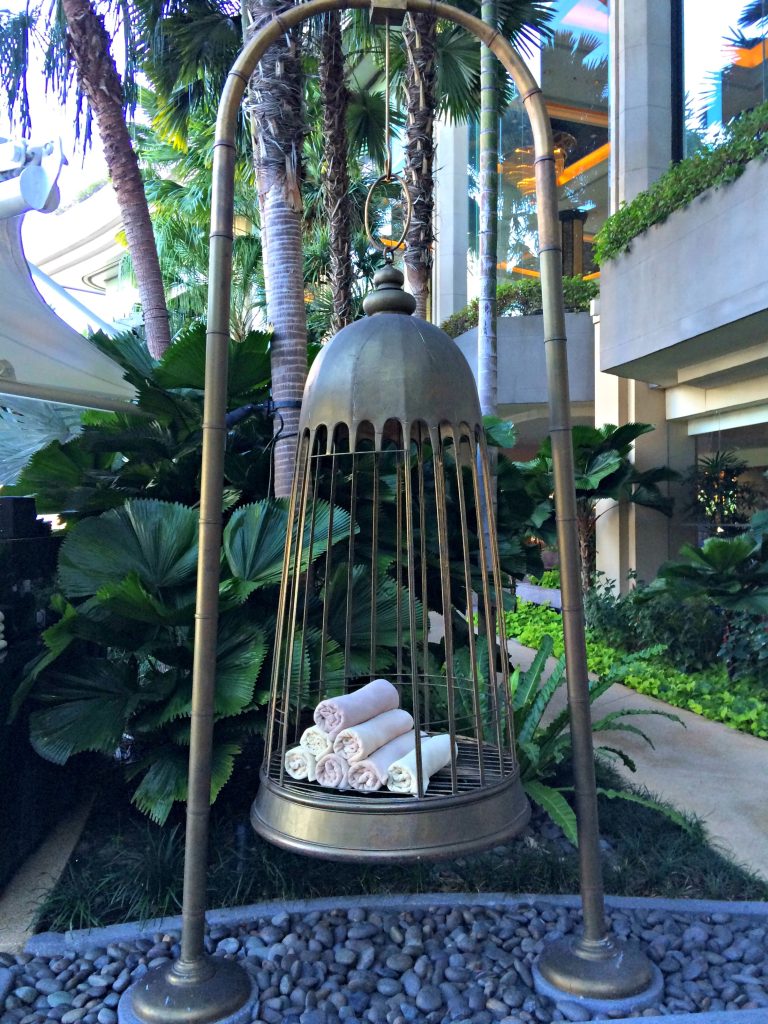
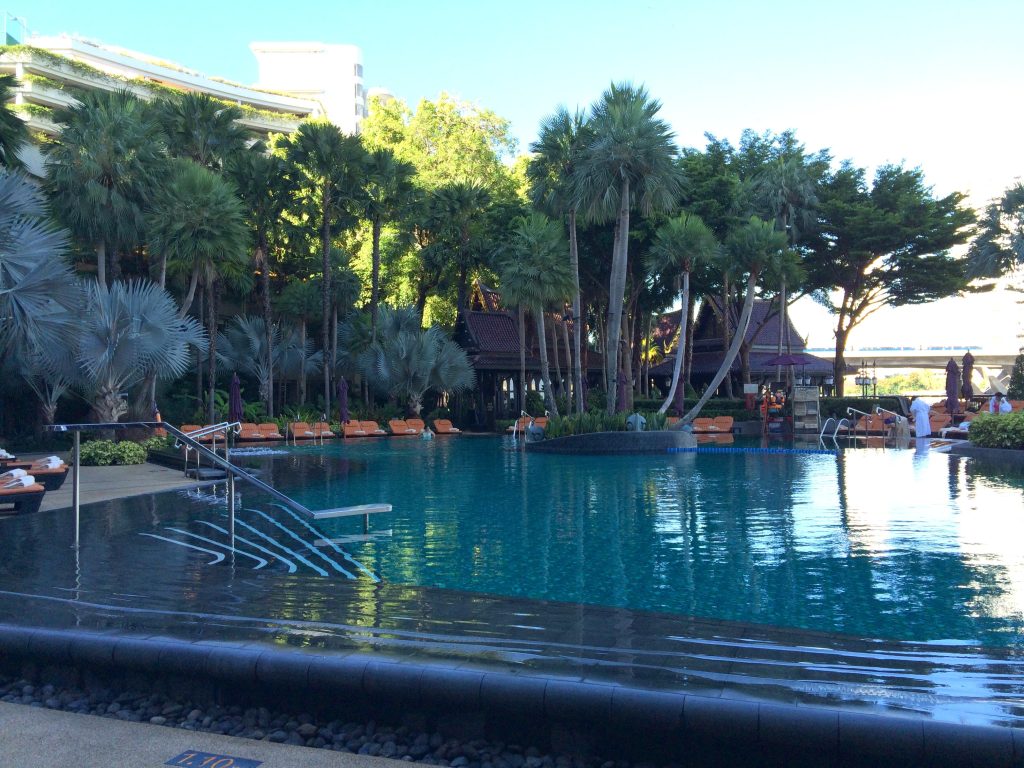
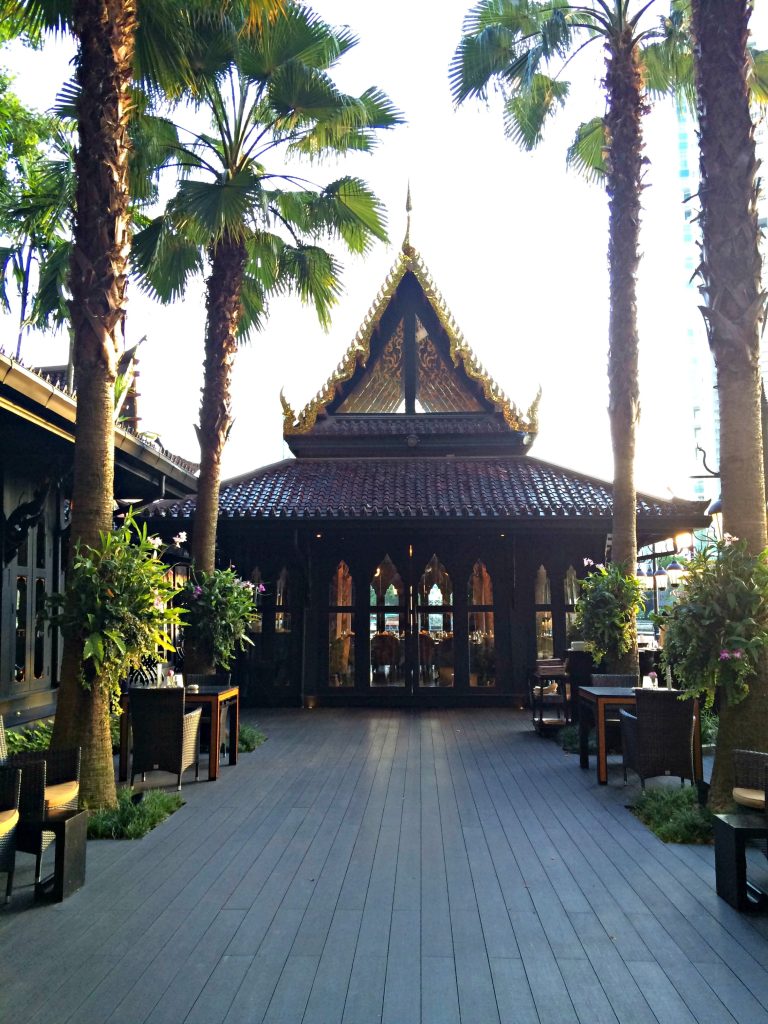
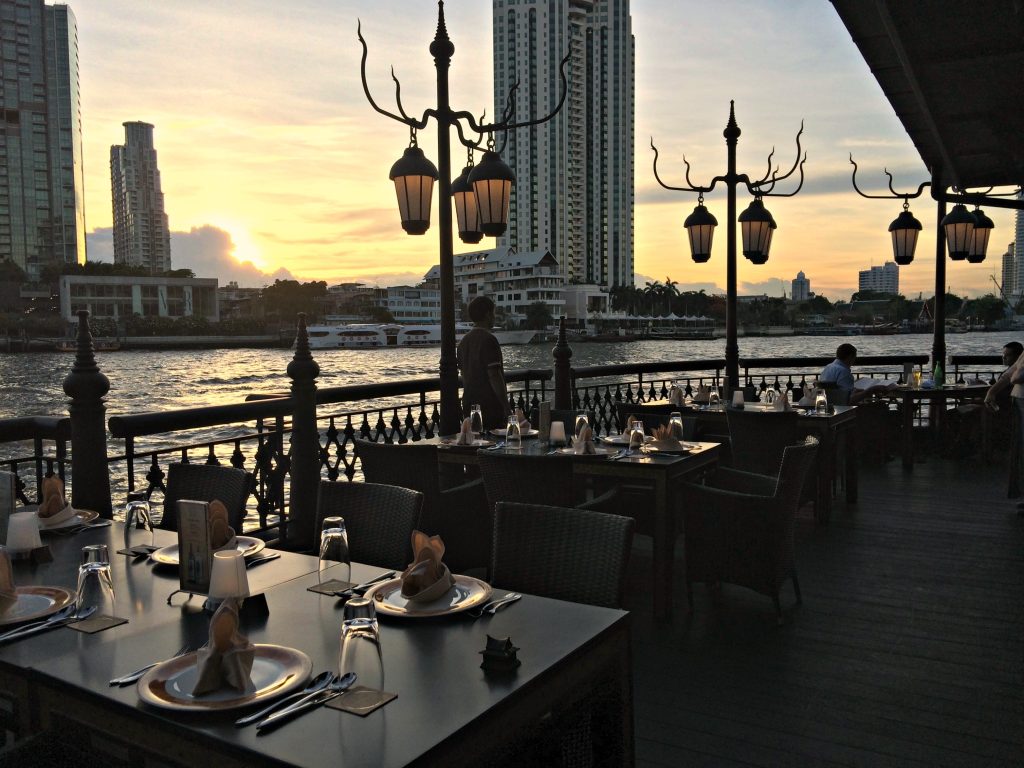
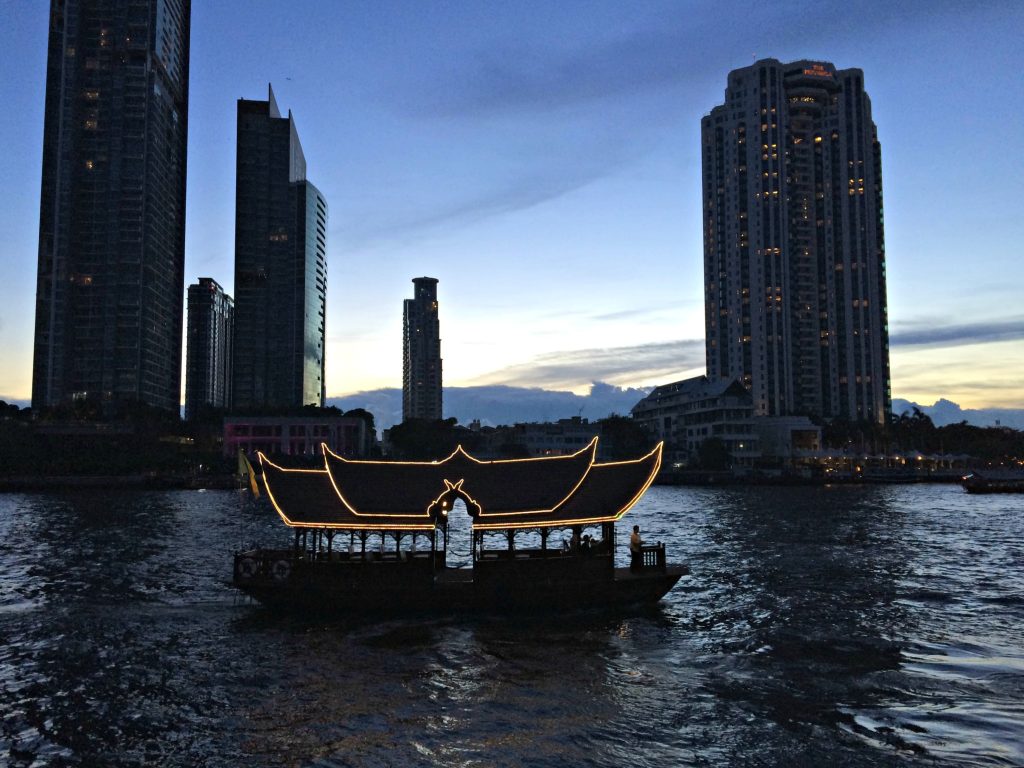
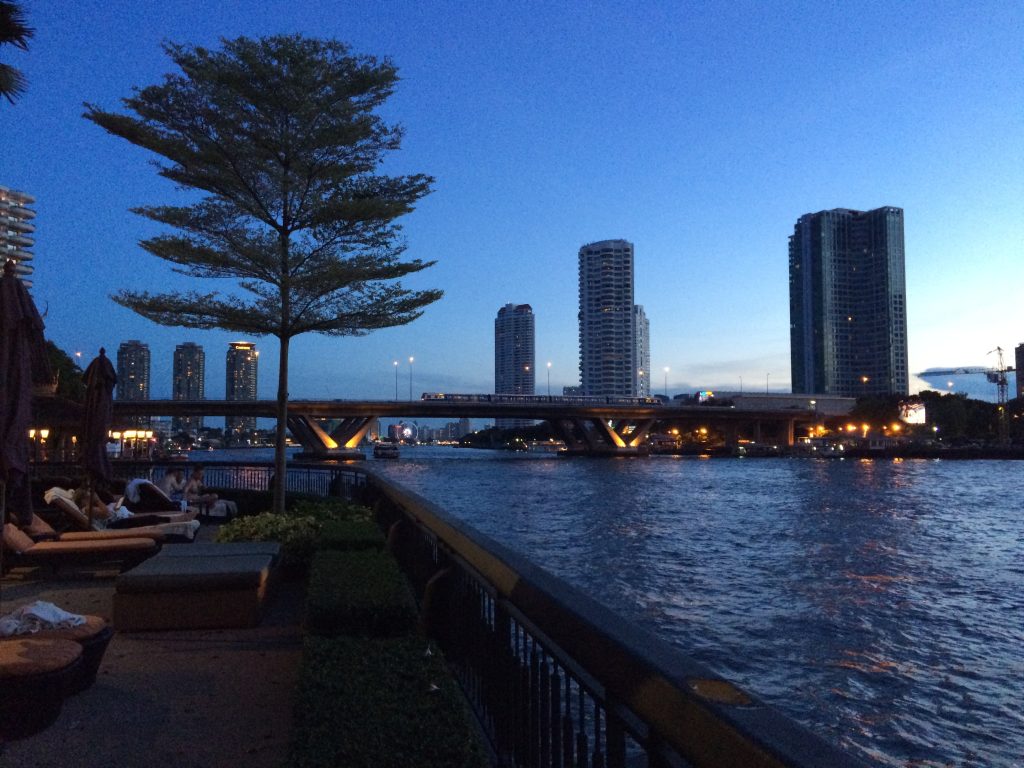
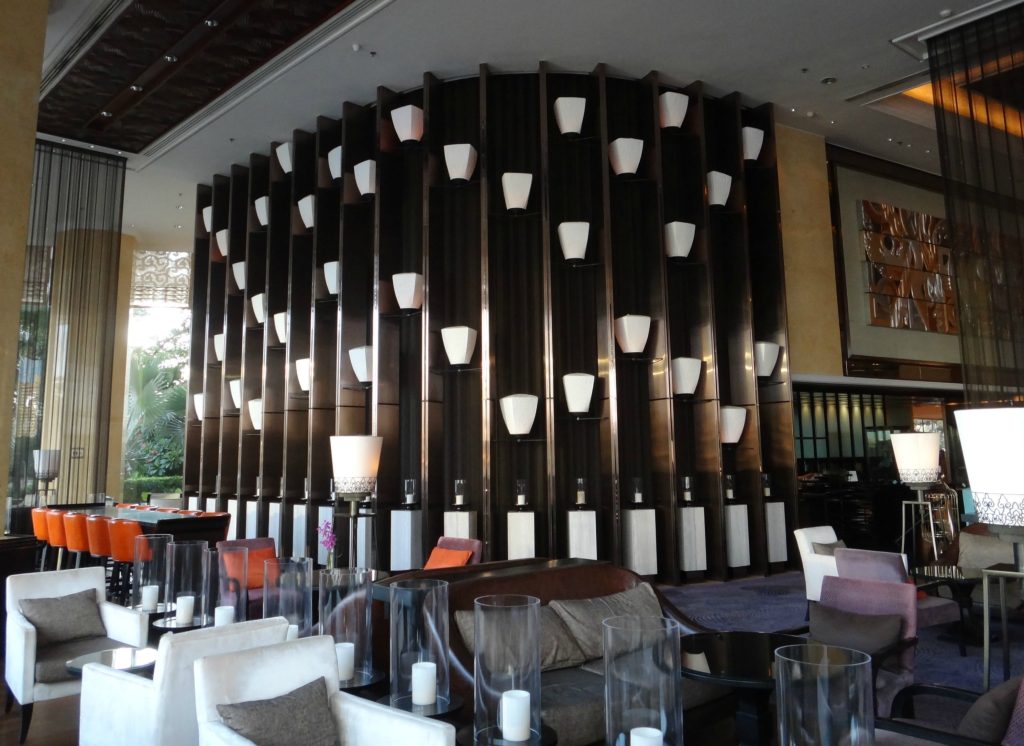
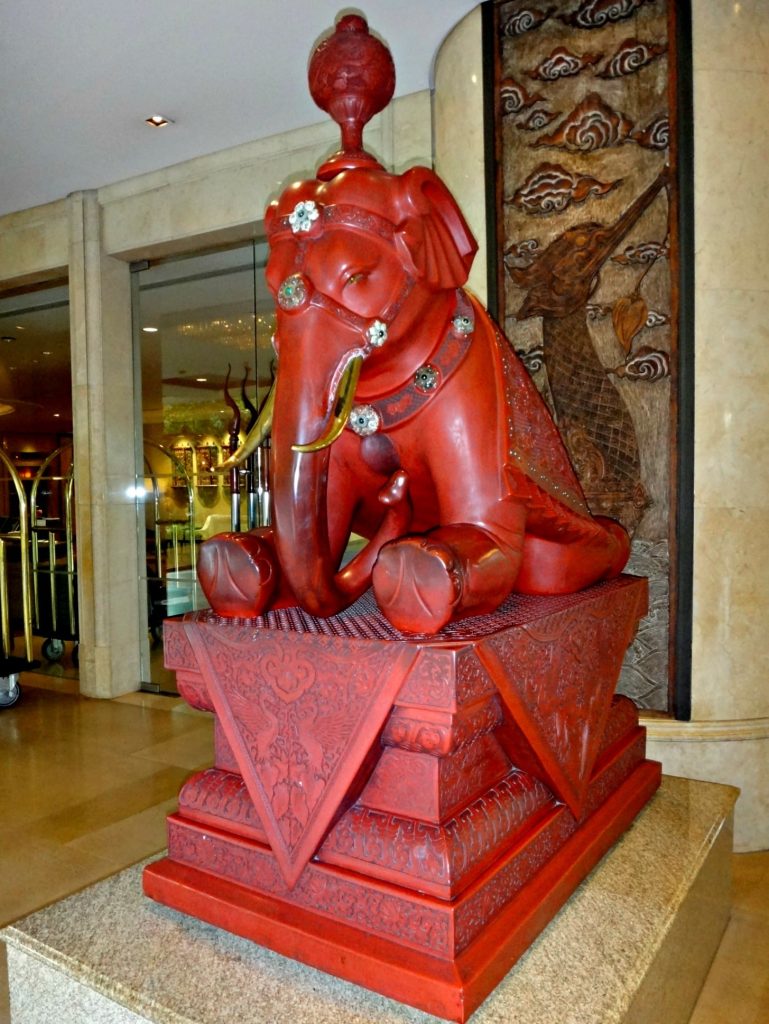
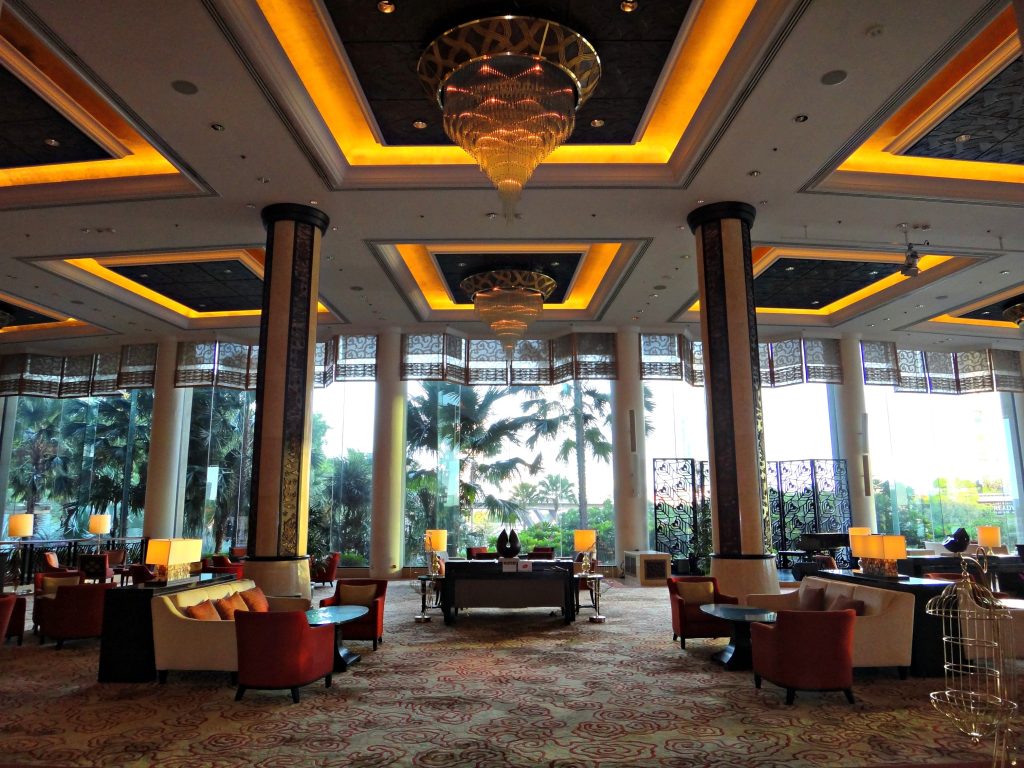
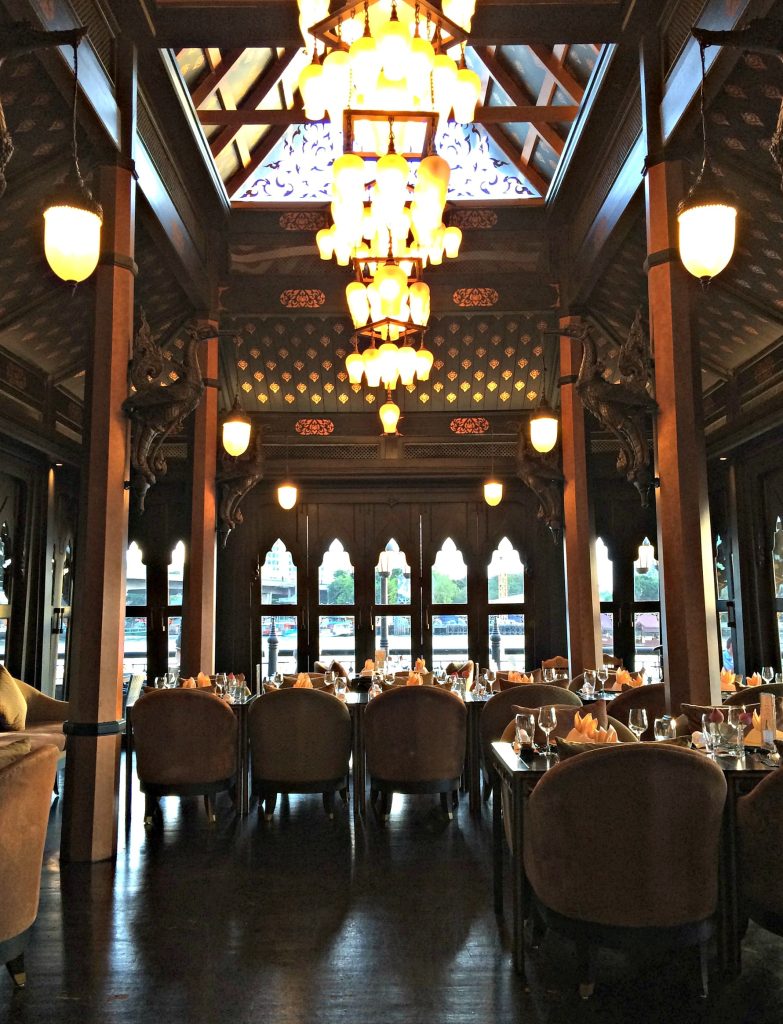
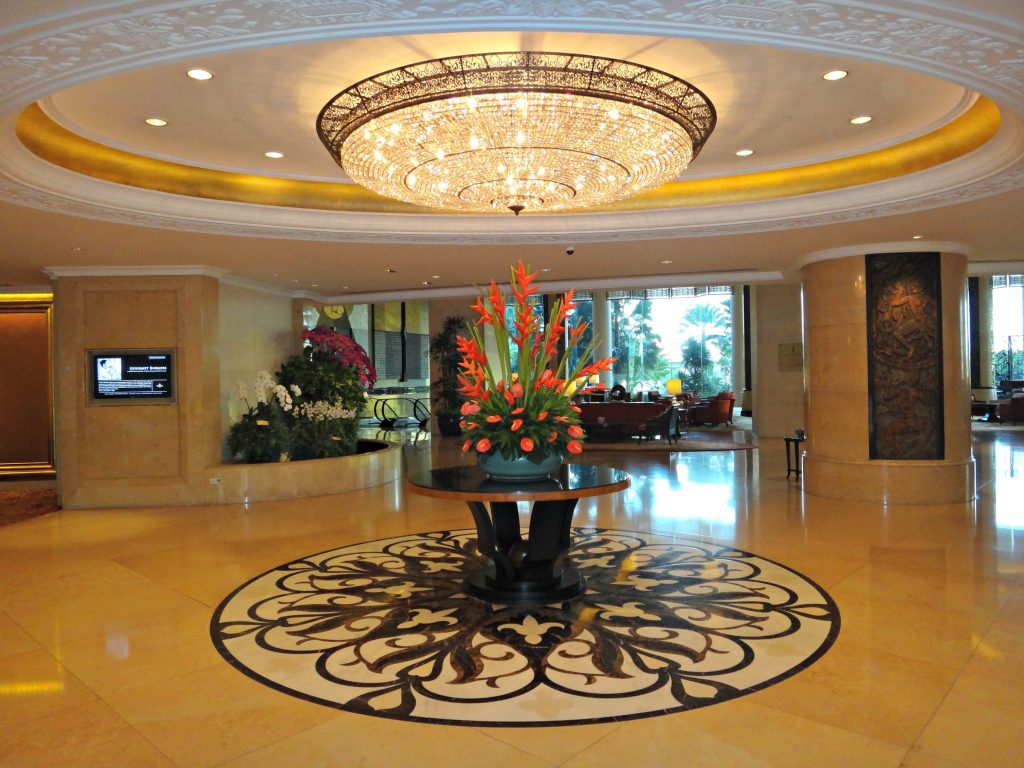
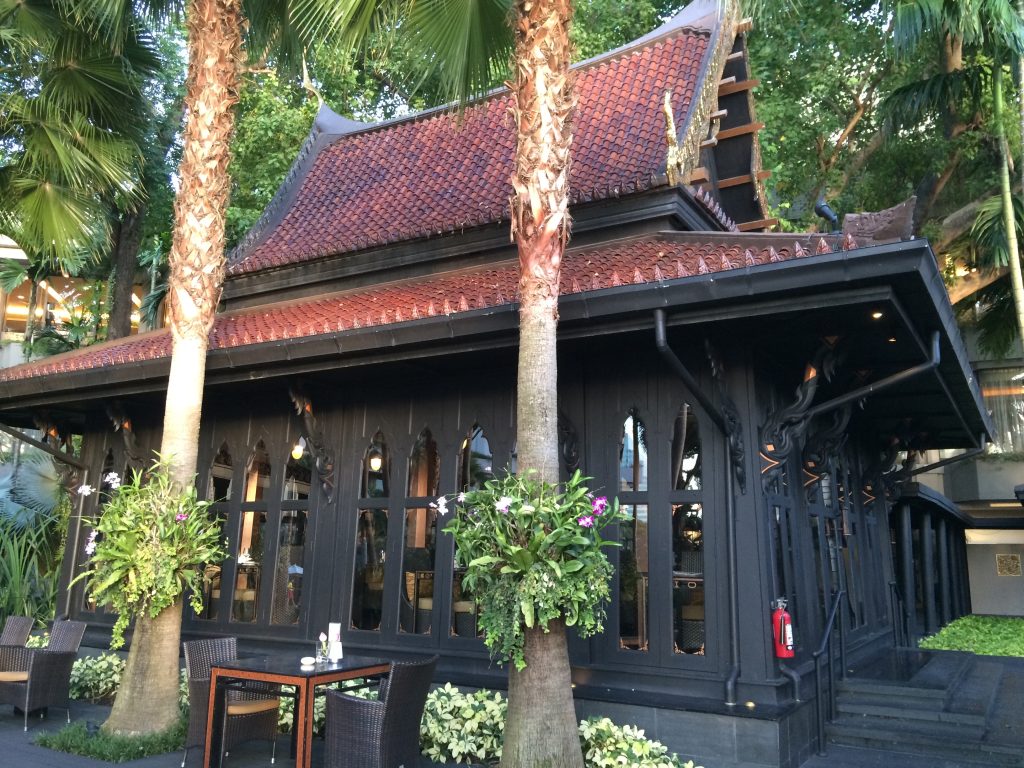
For the next two days our hosts toured us around the capital. With a local, English speaking guide, our own driver, and family members of friends here in the States, we saw the best of Bangkok without the crowds.
The Grand Palace
There are places in Bangkok that are immaculate. The palace is one of them. The architecture is astonishing. White plaster, gold gilding, and colorful tiles and mirrors adorn everything. The Grand Palace is comprised of the Royal family’s residence, throne halls, government buildings, galleries, and the Temple of the Emerald Buddha. When King Rama I took the throne in 1782, he began building a new palace on the river to serve as his residence and administrative offices, later becoming known as it is today, The Grand Palace. It absolutely must be one of the architectural wonders of the world and reflects some 200 years of leadership and design. Respect is required within The Grand Palace walls, so no hats, no shorts and no shoes inside the temples, and you must have your legs and shoulders covered.
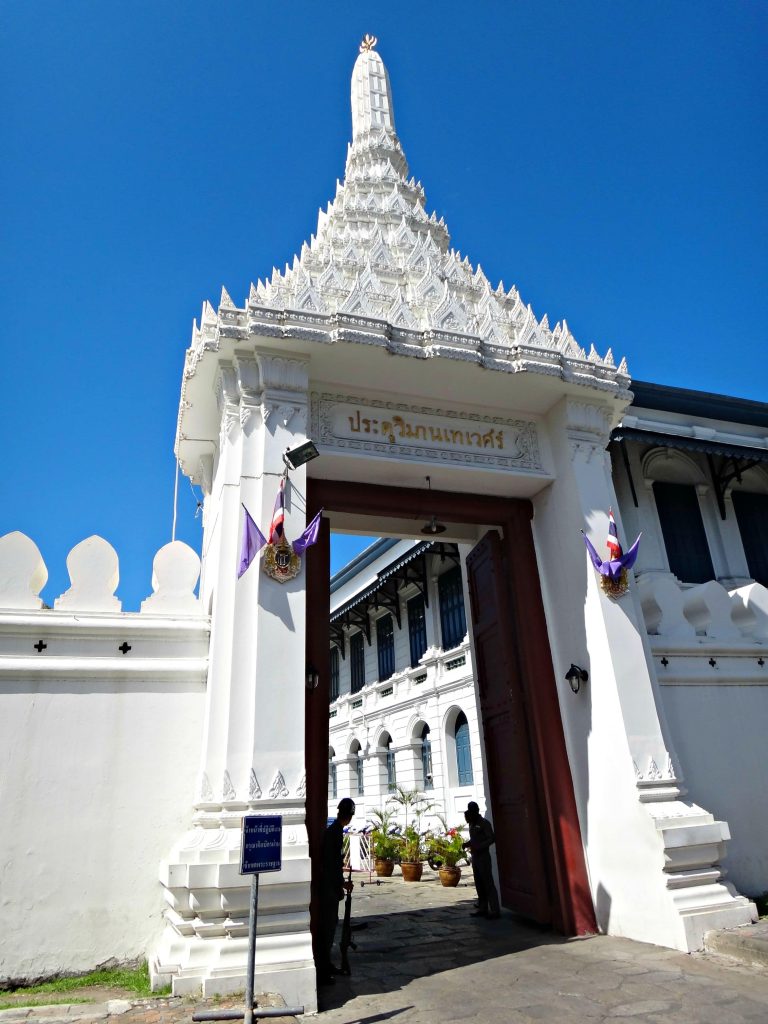
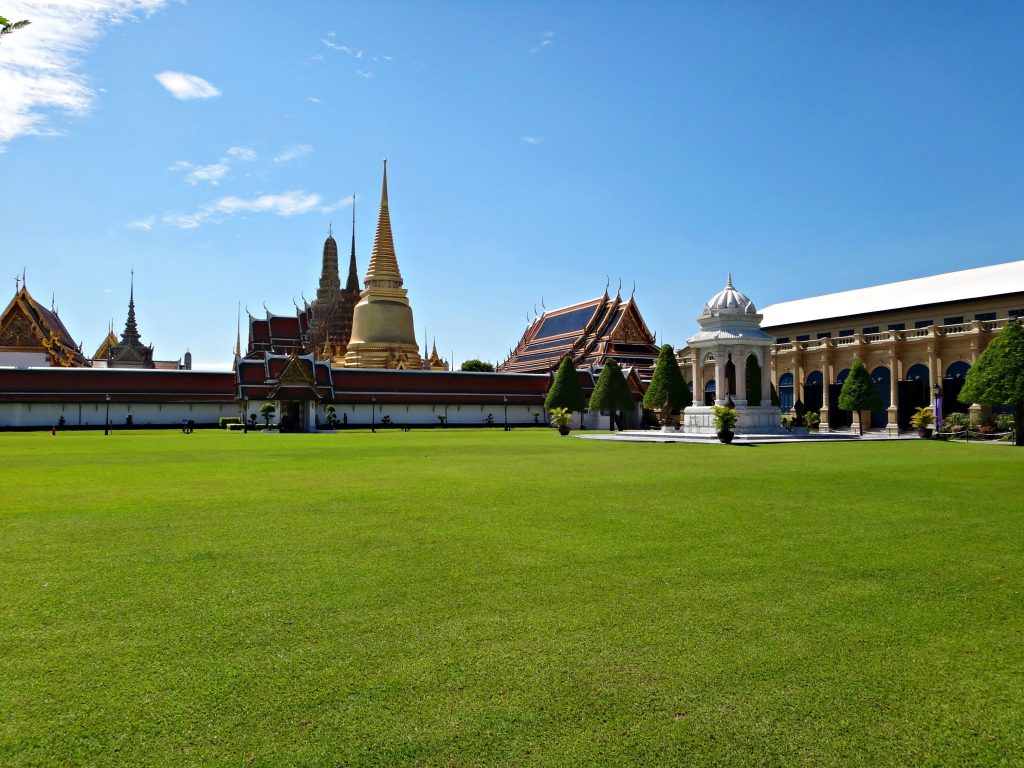
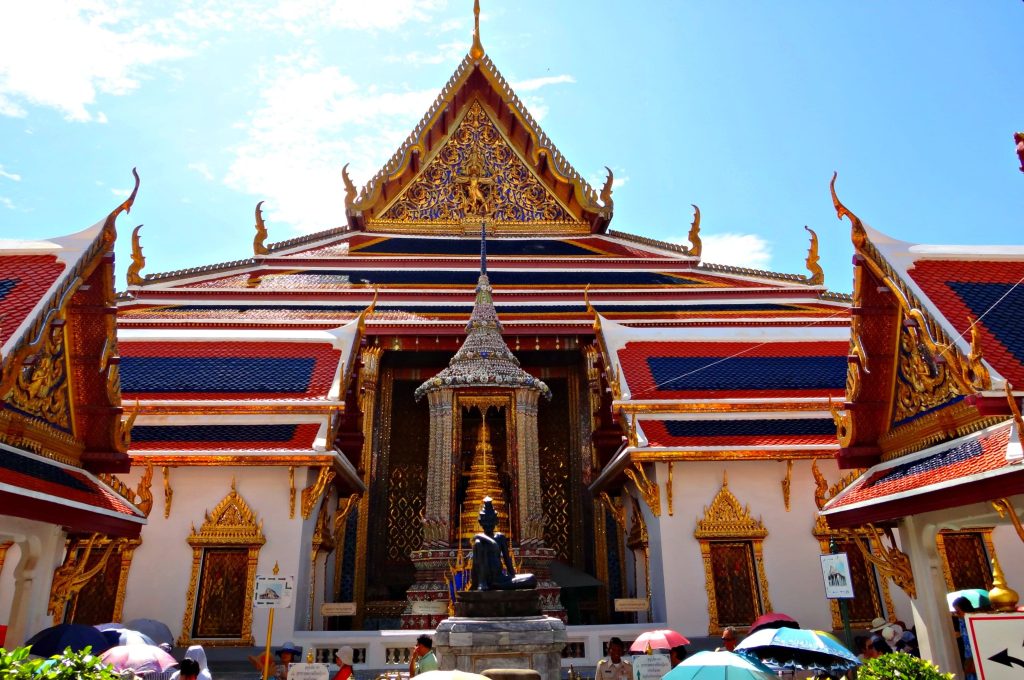
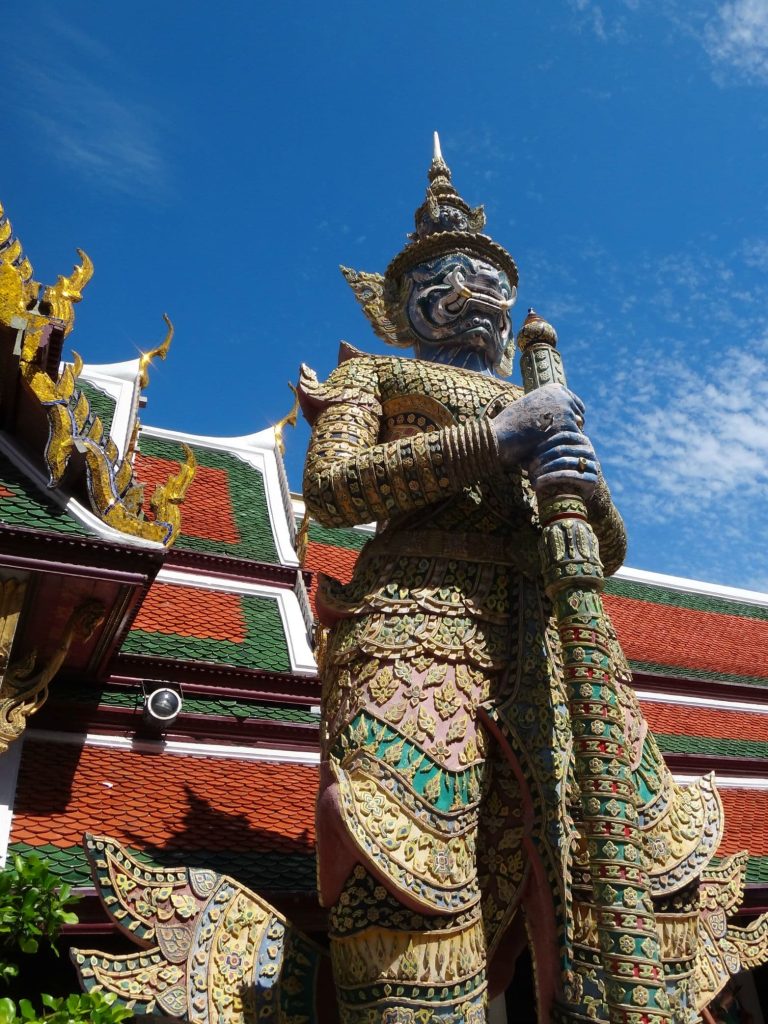
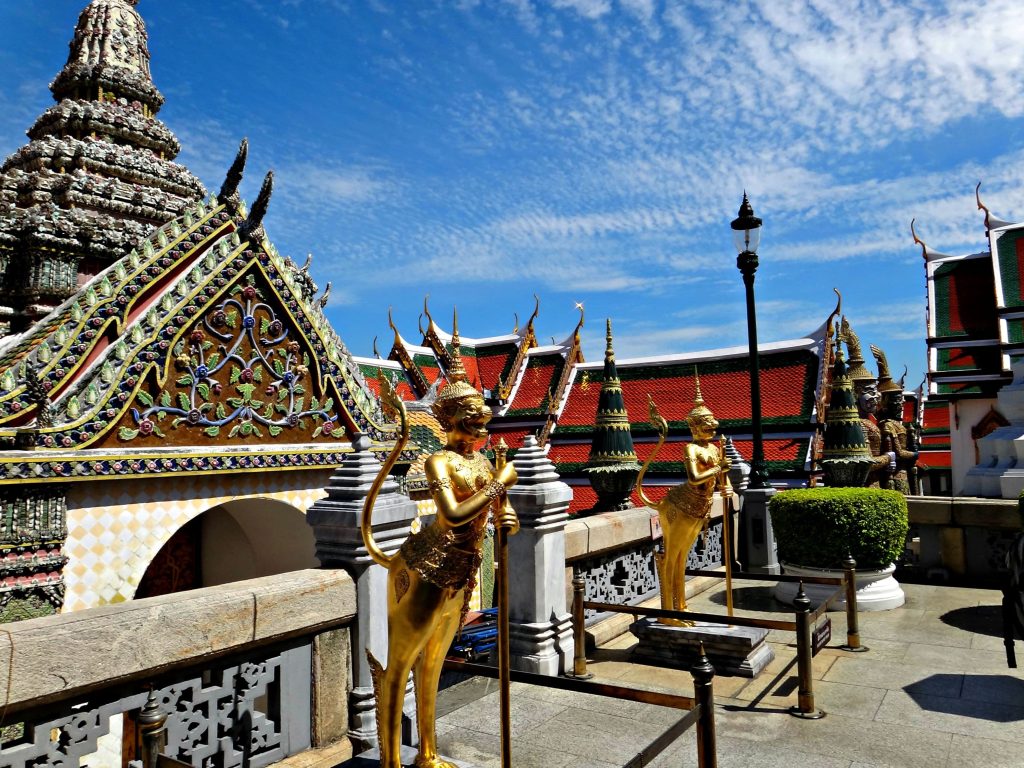
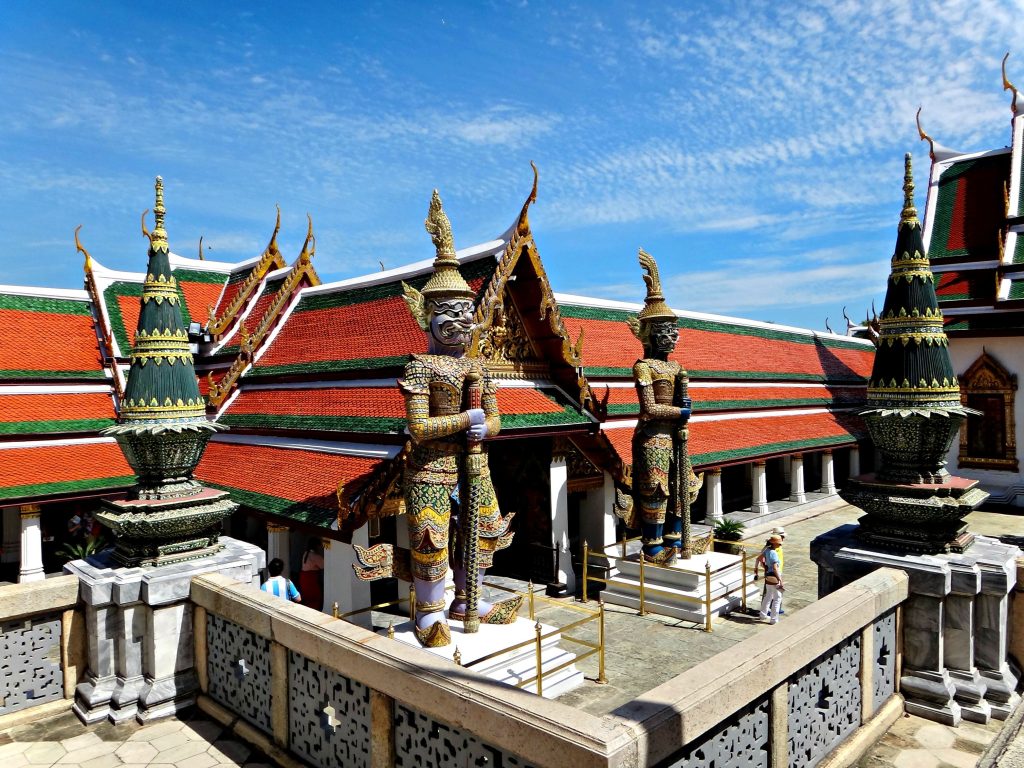
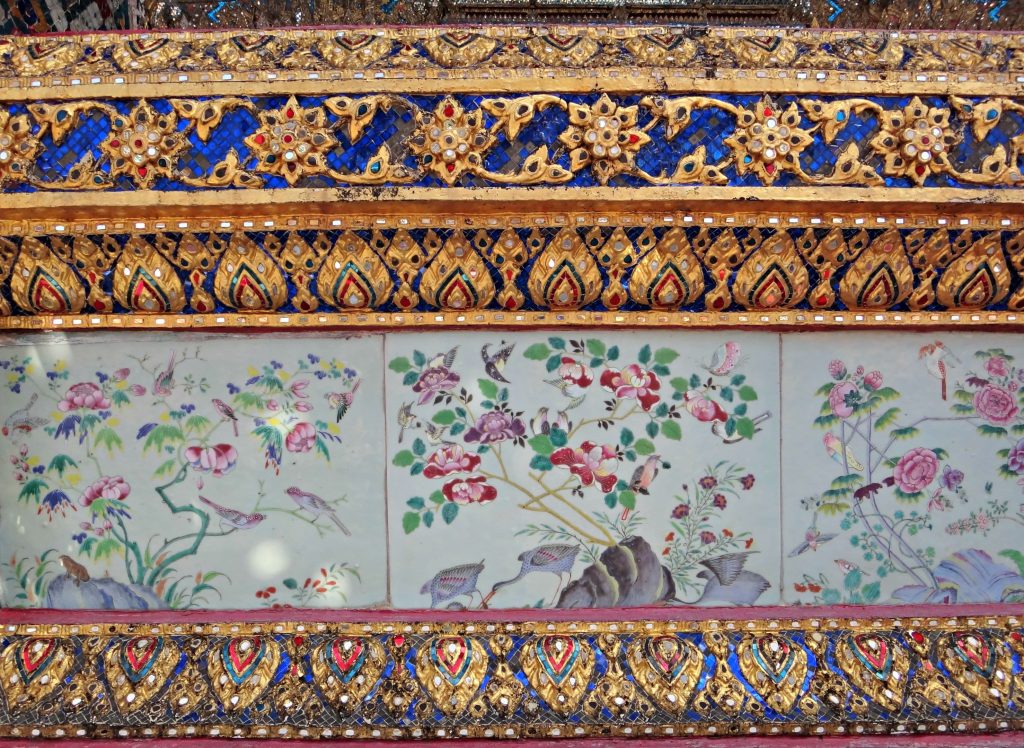
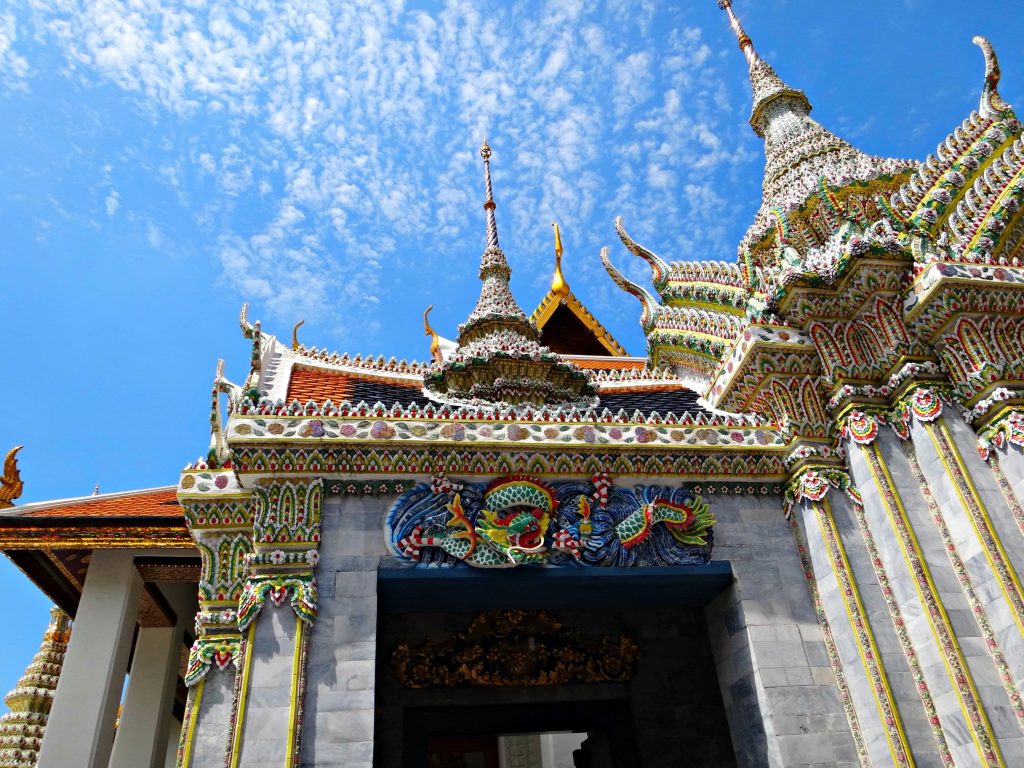
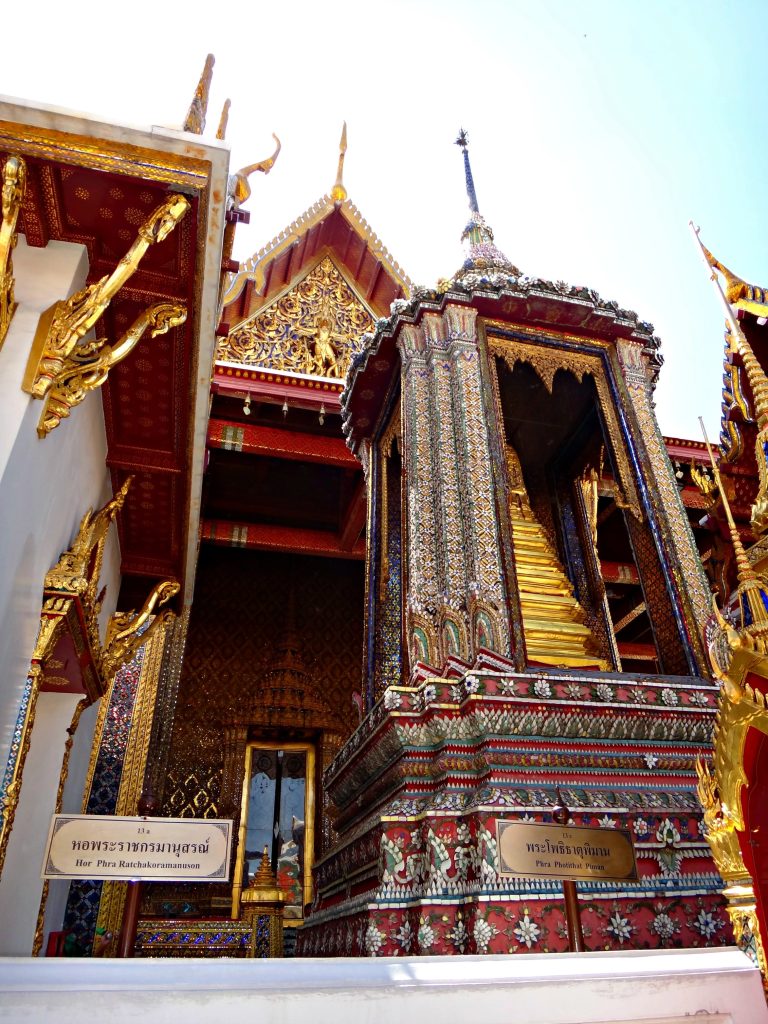
The Emerald Buddha
One of the most notable temples in Bangkok sits inside the walls of the Palace property. The Emerald Buddha is one of the most venerated sites in all of Thailand. This is where Buddhists come to pay respects to the Lord Buddha. Upon entering, guests are instructed to their knees to honor the Buddha. A bit confusing at first because we didn’t understand Thai, we quickly figured out what we were supposed to do. On the ground, on our hands and knees bowing, looking around, trying to be discreet and not stand out, we quietly snickered a little to ourselves at how obviously we looked like confused Americans.
Having done an enormous amount of research prior to leaving, I was quite shocked at the size of the Emerald Buddha. For something so highly respected, my first thought was, it’s so small… and so far away. The Buddha is actually carved of green jade and was found in Northern Thailand. The Abbott who found it cased in plaster noticed a portion of the nose had flaked off. Originally thinking it was emerald, the name the Emerald Buddha still stands today. Unfortunately, photos of the Buddha aren’t allowed. Due to its deeply recessed placement inside the temple which is guarded by ropes, even a close up view isn’t feasible. A pair of opera glasses would have really helped. The Buddha has three costumes that are changed based on the seasons, but the Thai architecture and the altar it sits on are arguably as equally impressive as the Buddha himself. The below pictures are of the outside of the temple. It’s easily spotted inside the palace walls as the temple with the blue roof. The temple bells lining the bottom of the roof are to ward off evil spirits, and I was able to bring one home with me from the trip.
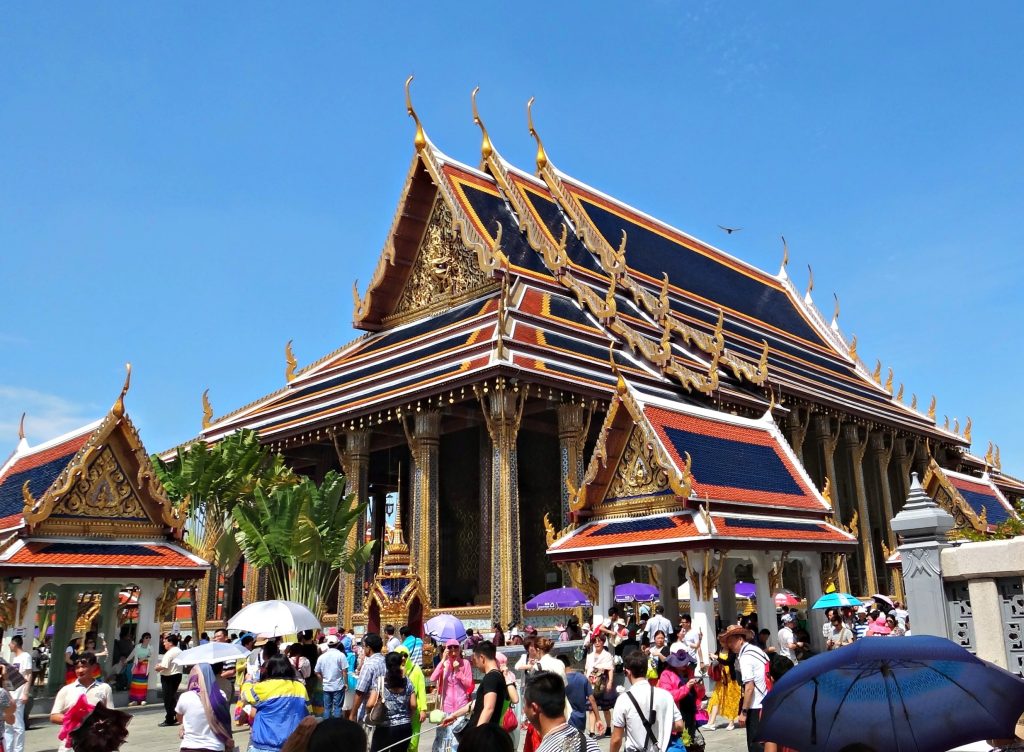
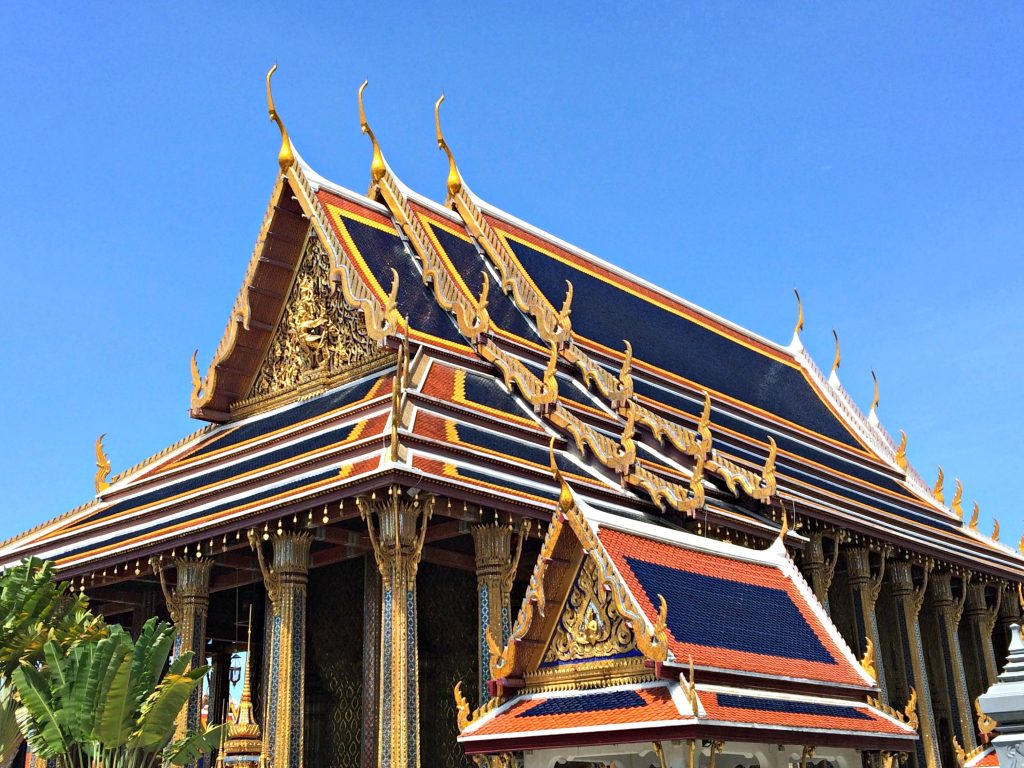
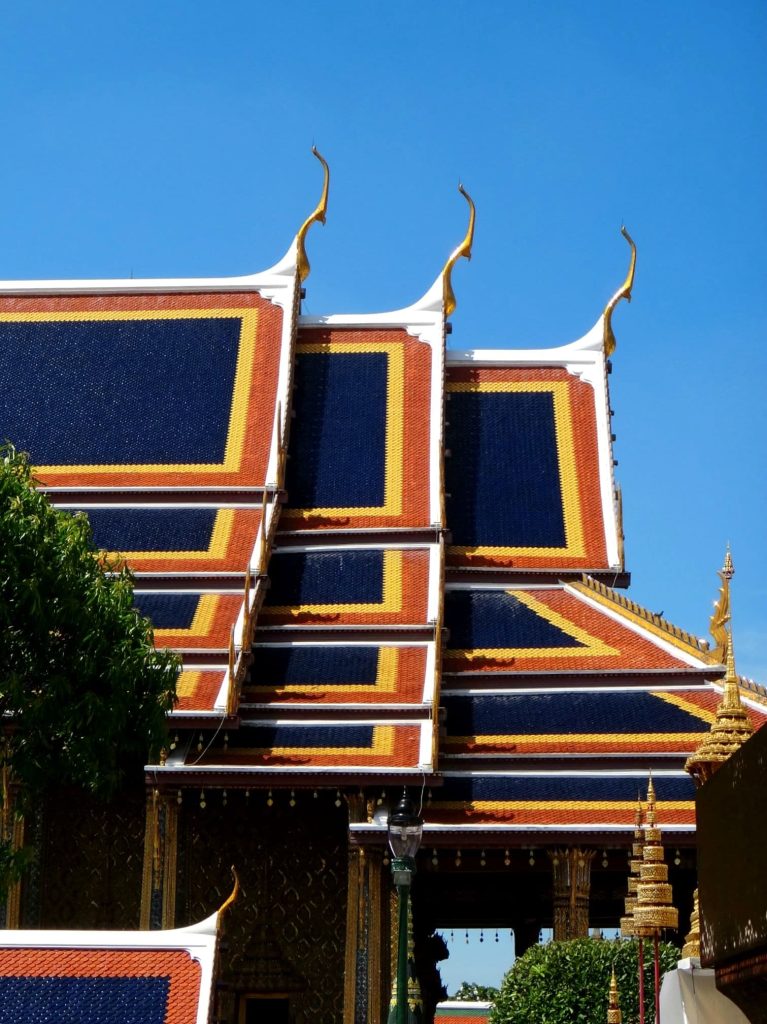
The Upper Terrace
The four main monuments here are the Golden Chedi, The Model of Angor Wat, Phra Mondrop, and the Royal Pantheon. The Golden Chedi, built in the Sri Lankan style, contains the ashes of the Lord Buddha, and the striking gold pagoda is one of the first structures to catch your eye with it’s almost blinding, gleaming gold finish. The model of Angokor Wat (a temple complex in Cambodia) was commissioned by King Rama IV. When France tried to colonize Cambodia, the King ordered 2000 Thai men to go to Cambodia, dismantle Angor Wat and bring it back to Bangkok to prove it was still under Siam (the original name of Thailand) control. When the Cambodian Khmer people ambushed the Thai army, the King soon realized Angor Wat couldn’t be brought back and ordered a model to be built instead. He passed before seeing its completion.The Mondrop is the library for the Buddhist Cannons at the Grand Palace. It was built by King Rama I and houses sacred Buddhist scriptures. The library has 16 columns, colored, mirrored tiles, mother of pearl doors and cabinets, and miniature golden Buddhas. The last main monument in the Upper Terrace is the Royal Pantheon. It was originally built to house the Emerald Buddha. Today it houses life-sized statues of the Chakri Dynasty, and is only open one day a year, April 6th, aka Chakri Day.
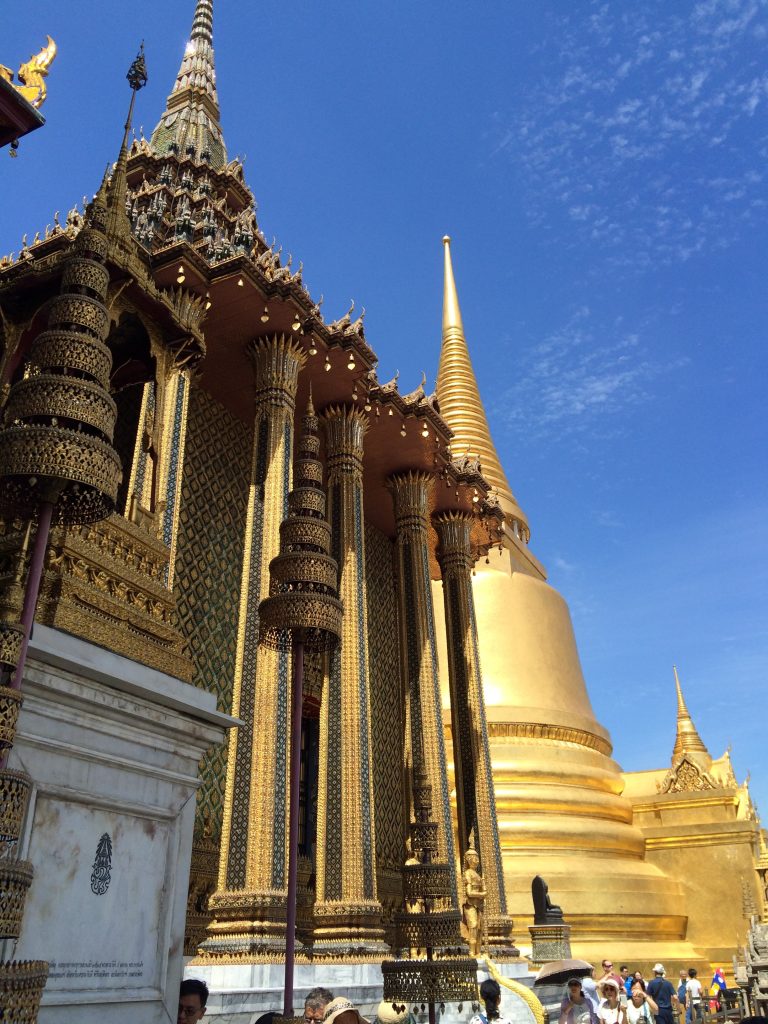
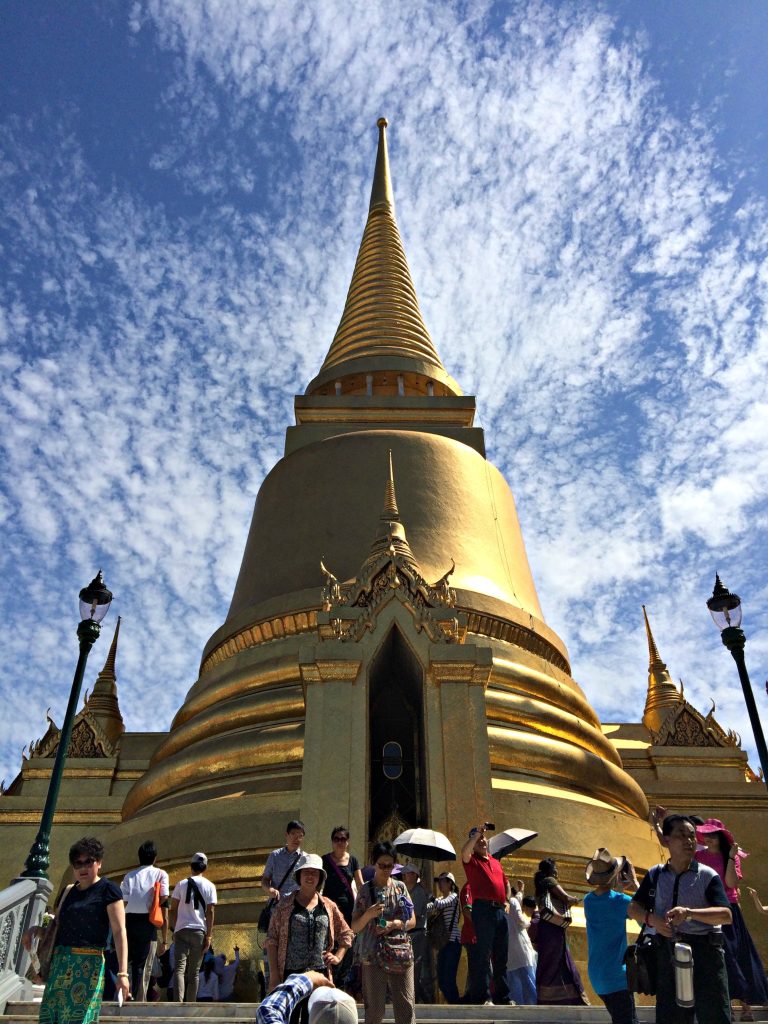
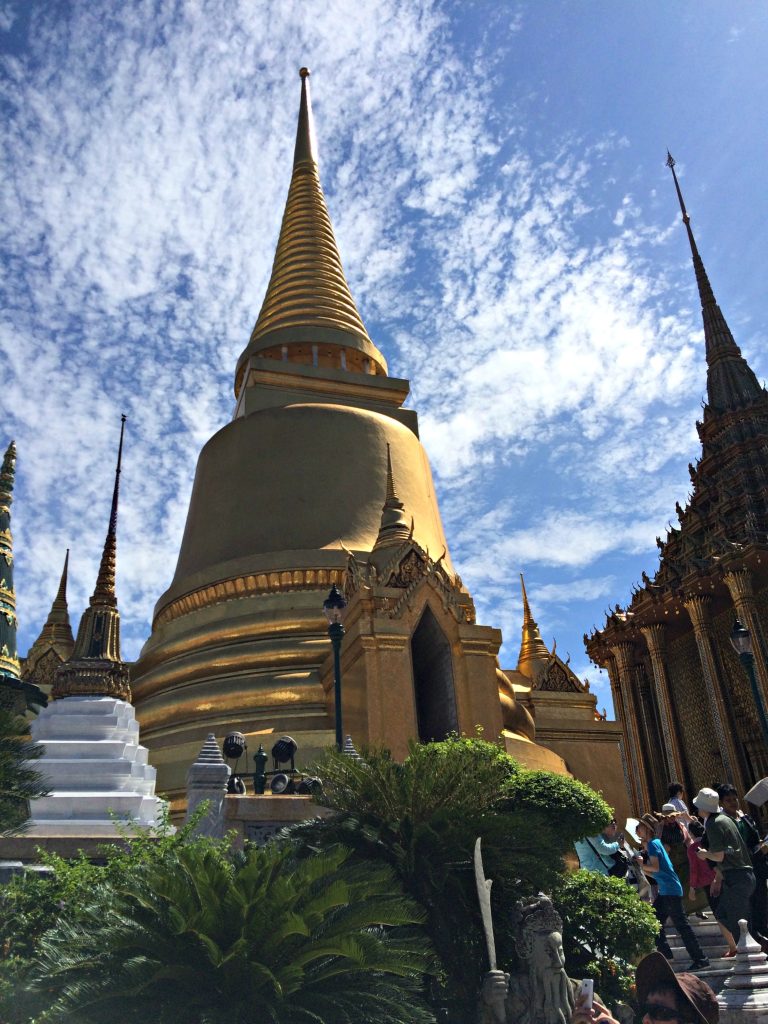
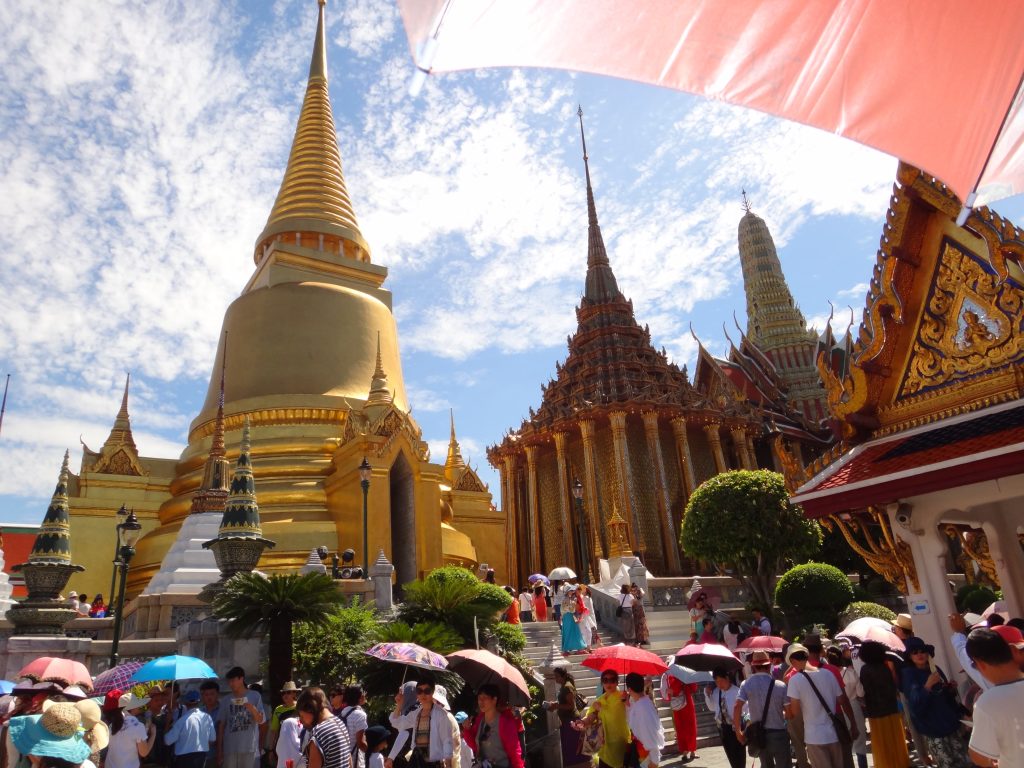
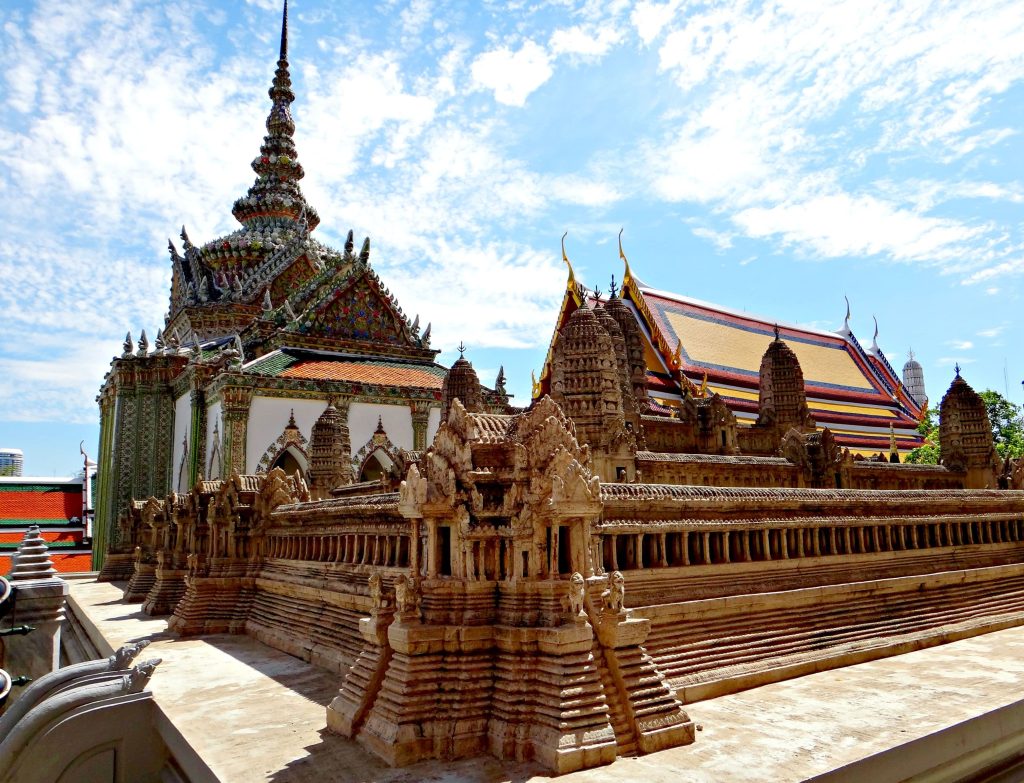
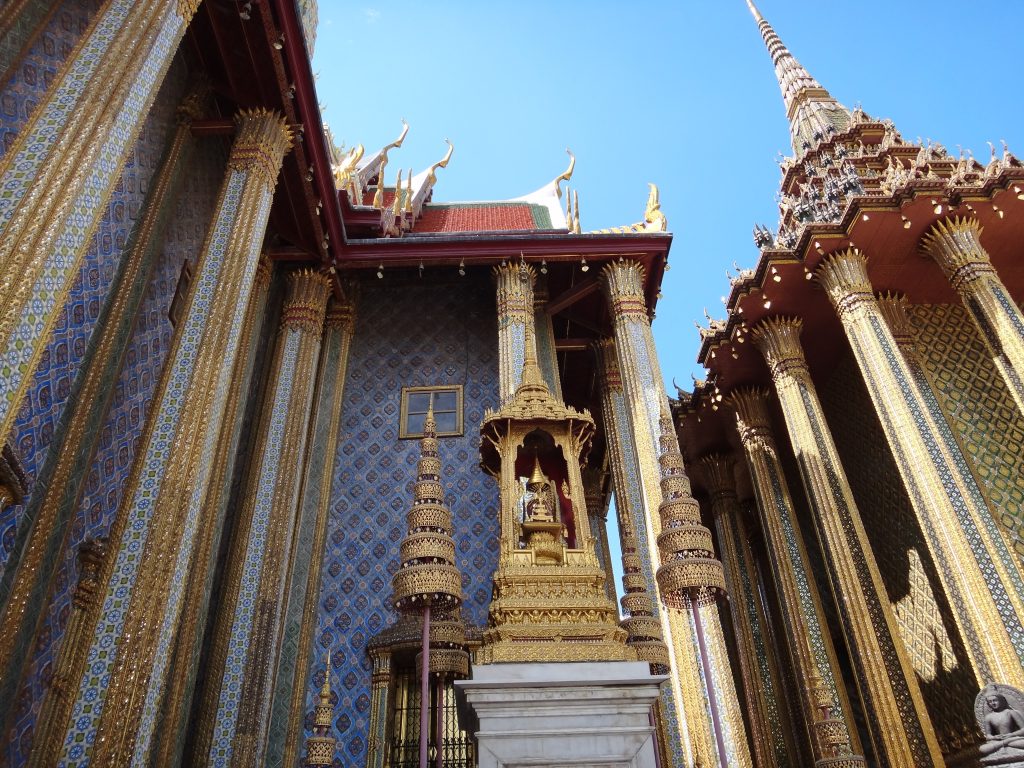
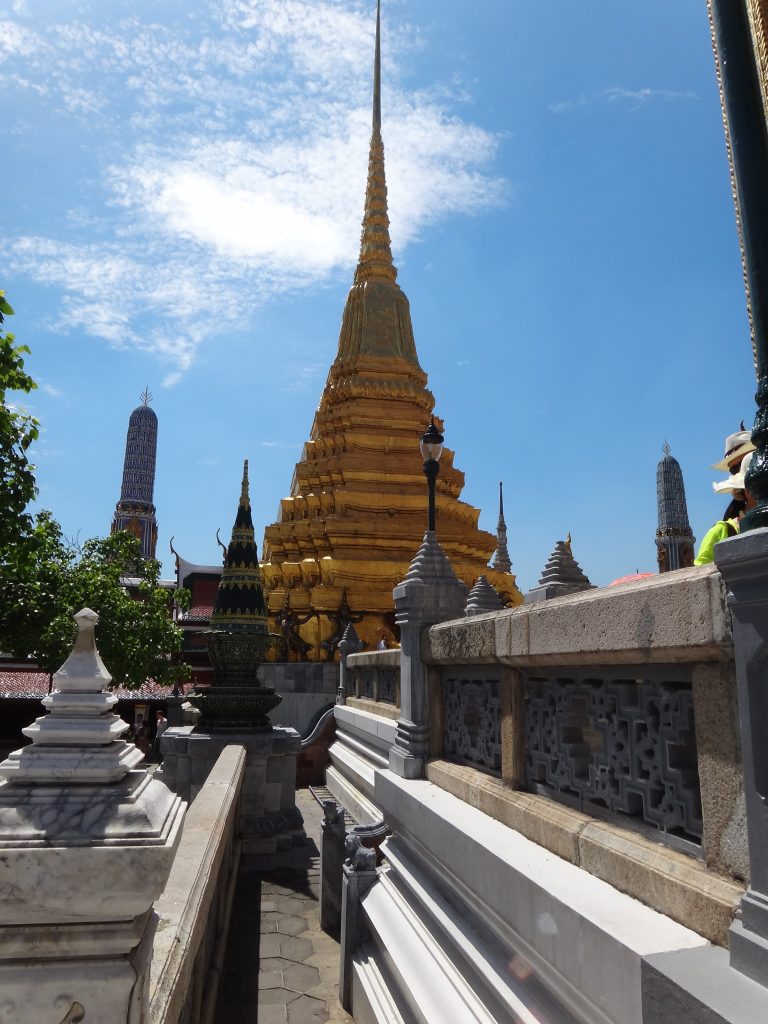
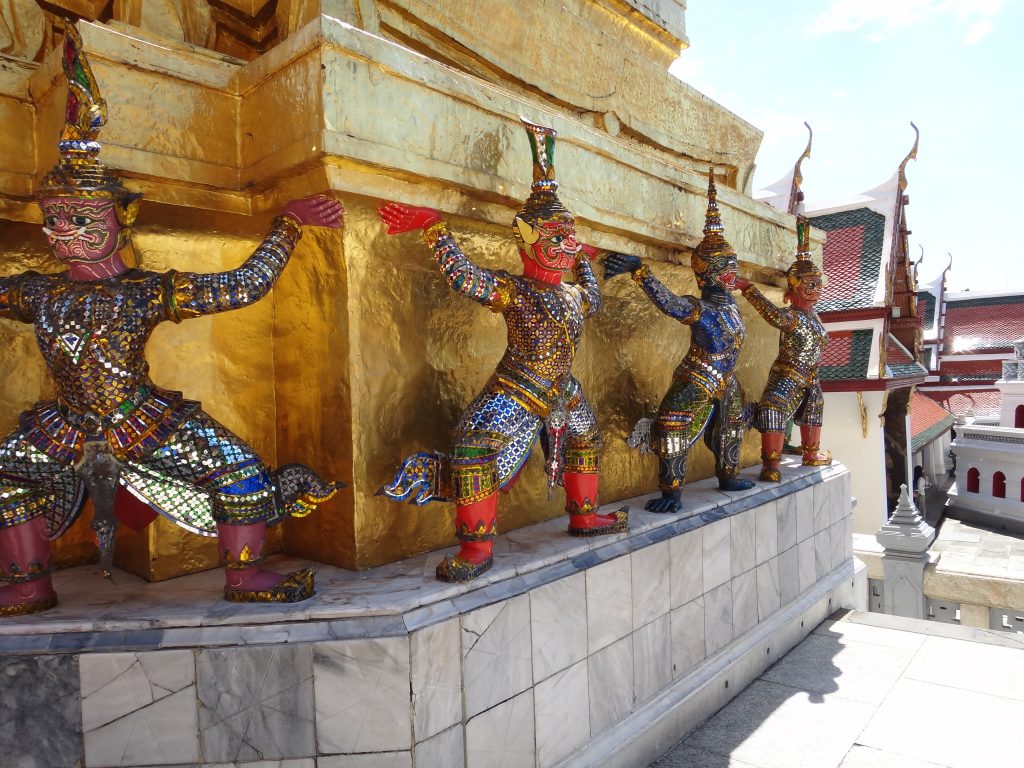
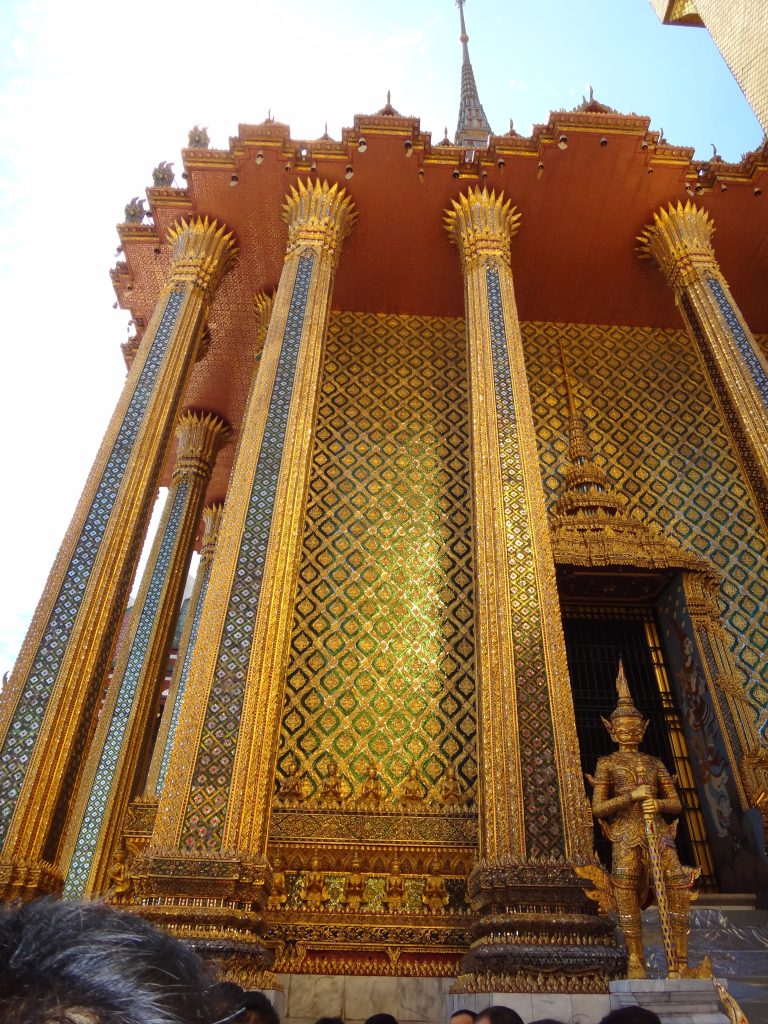
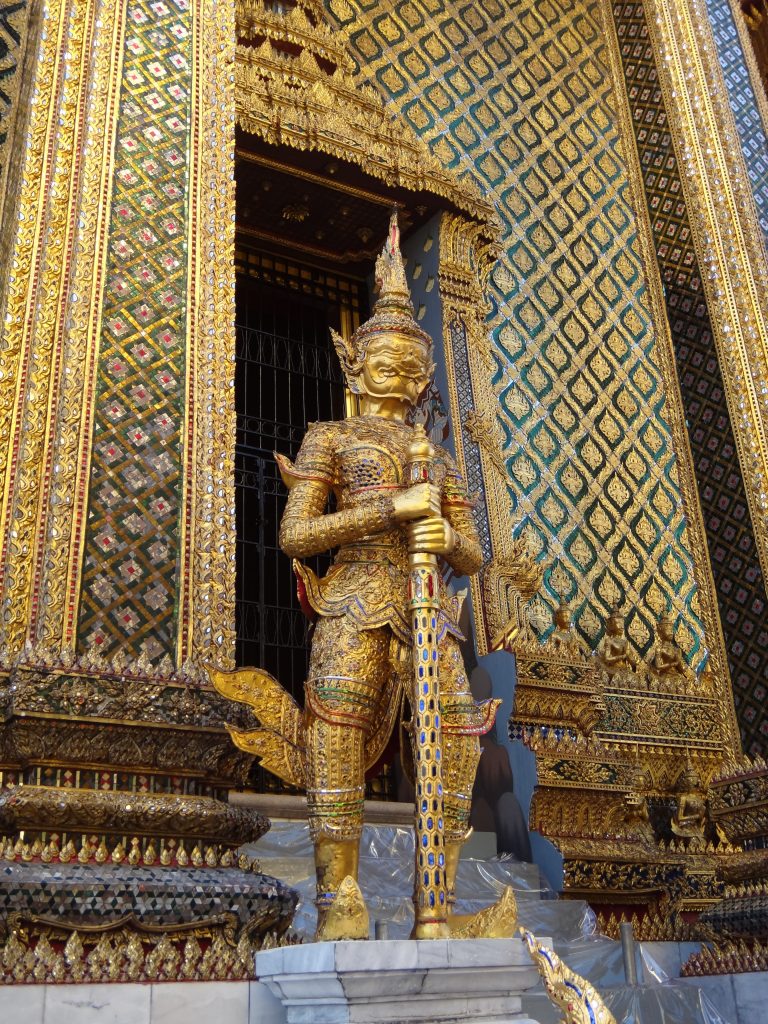
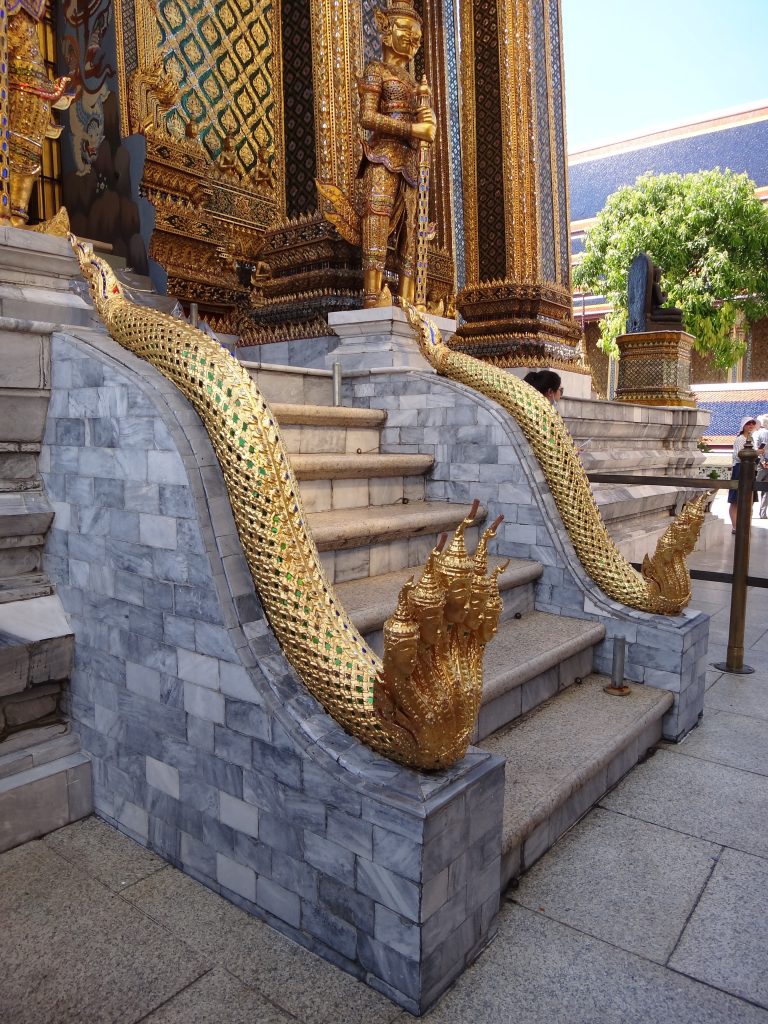
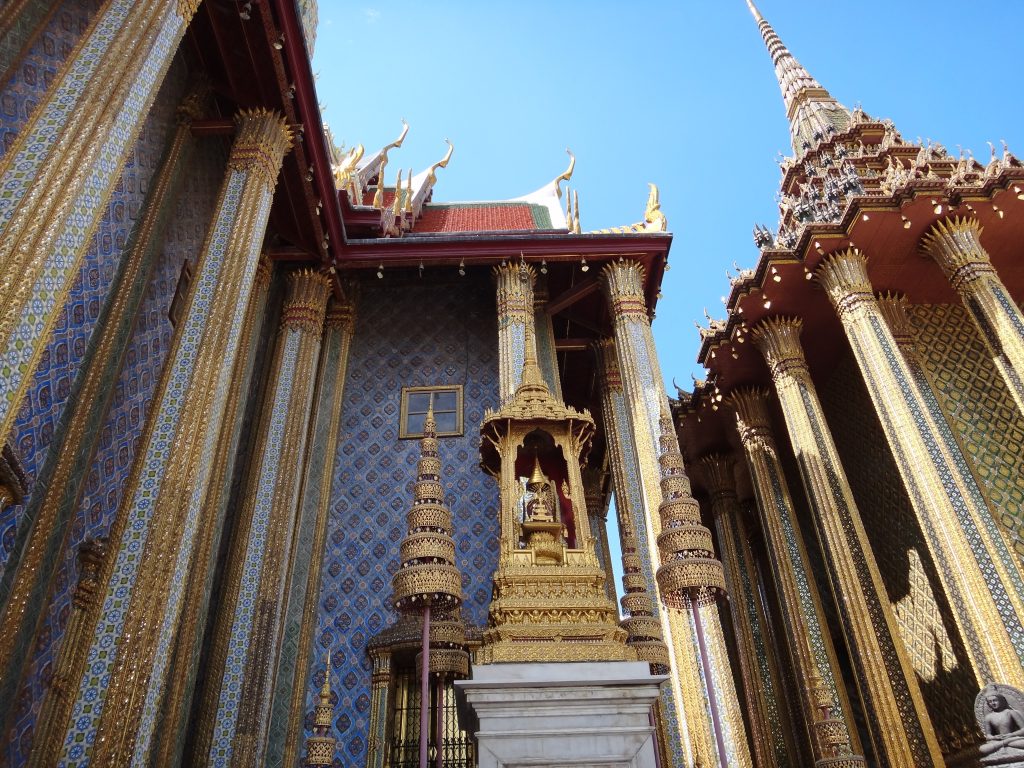
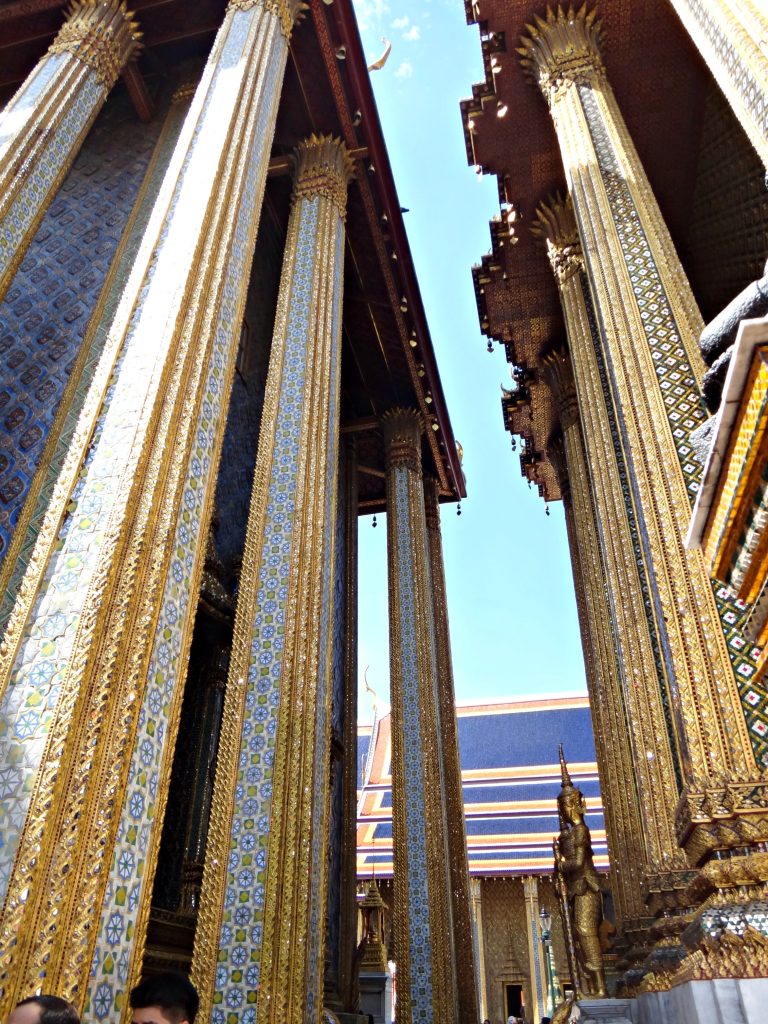
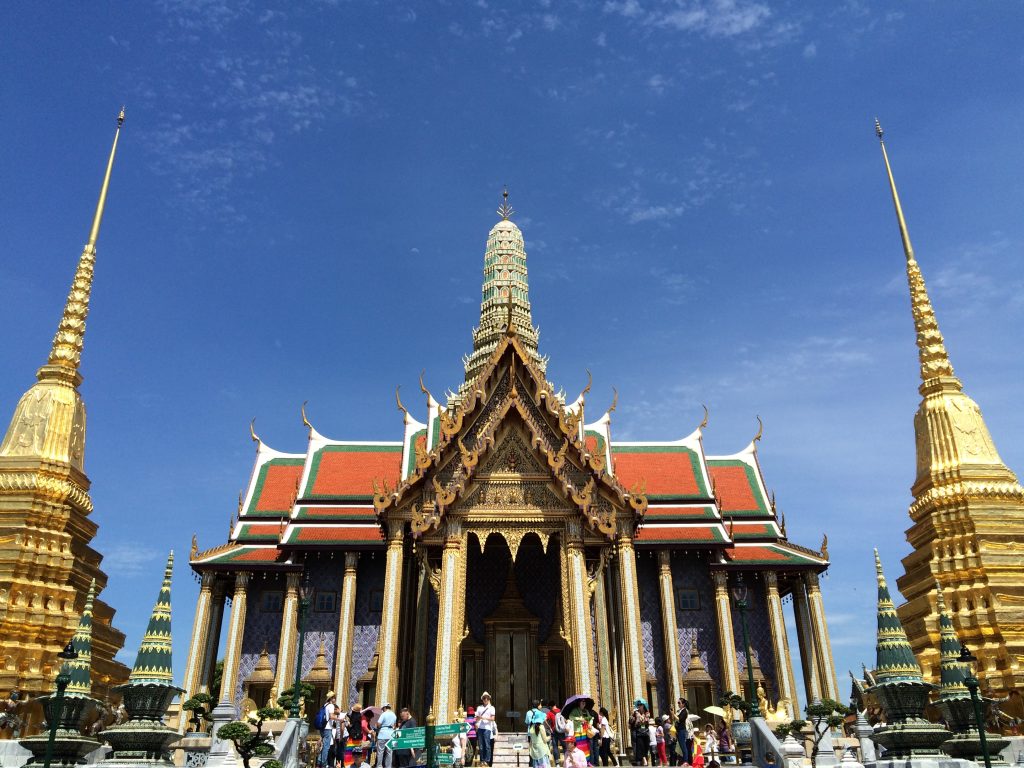
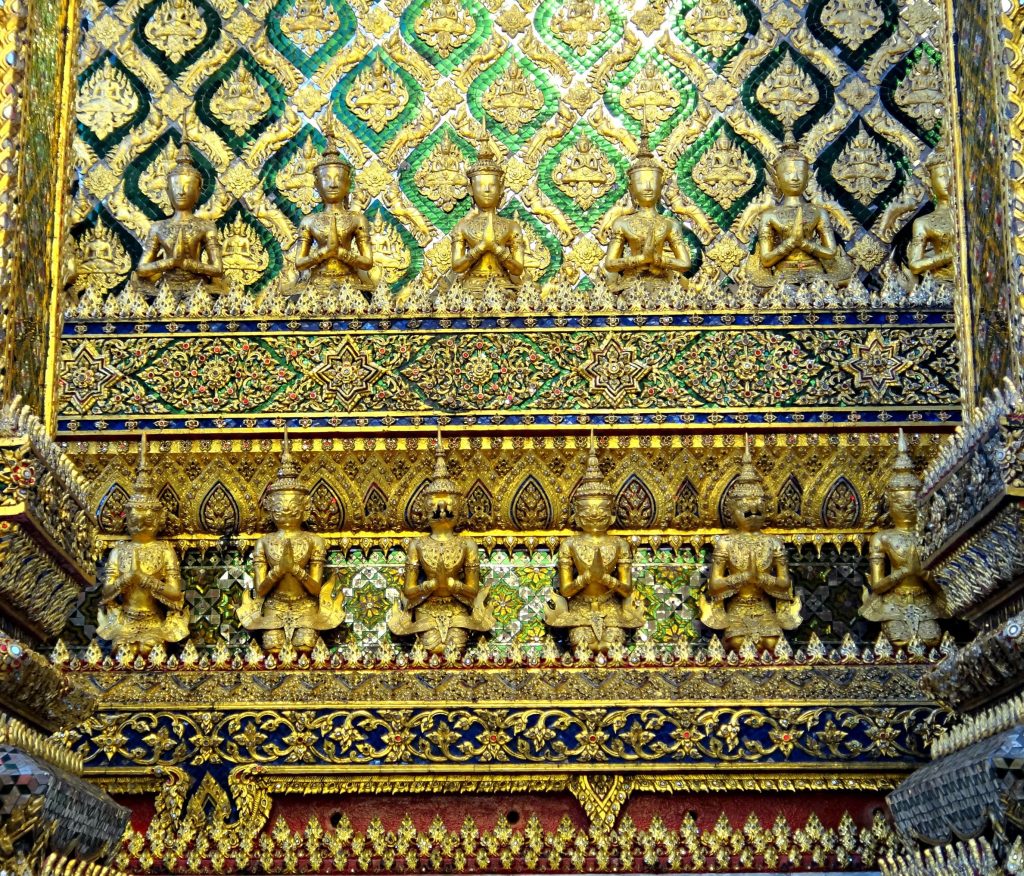
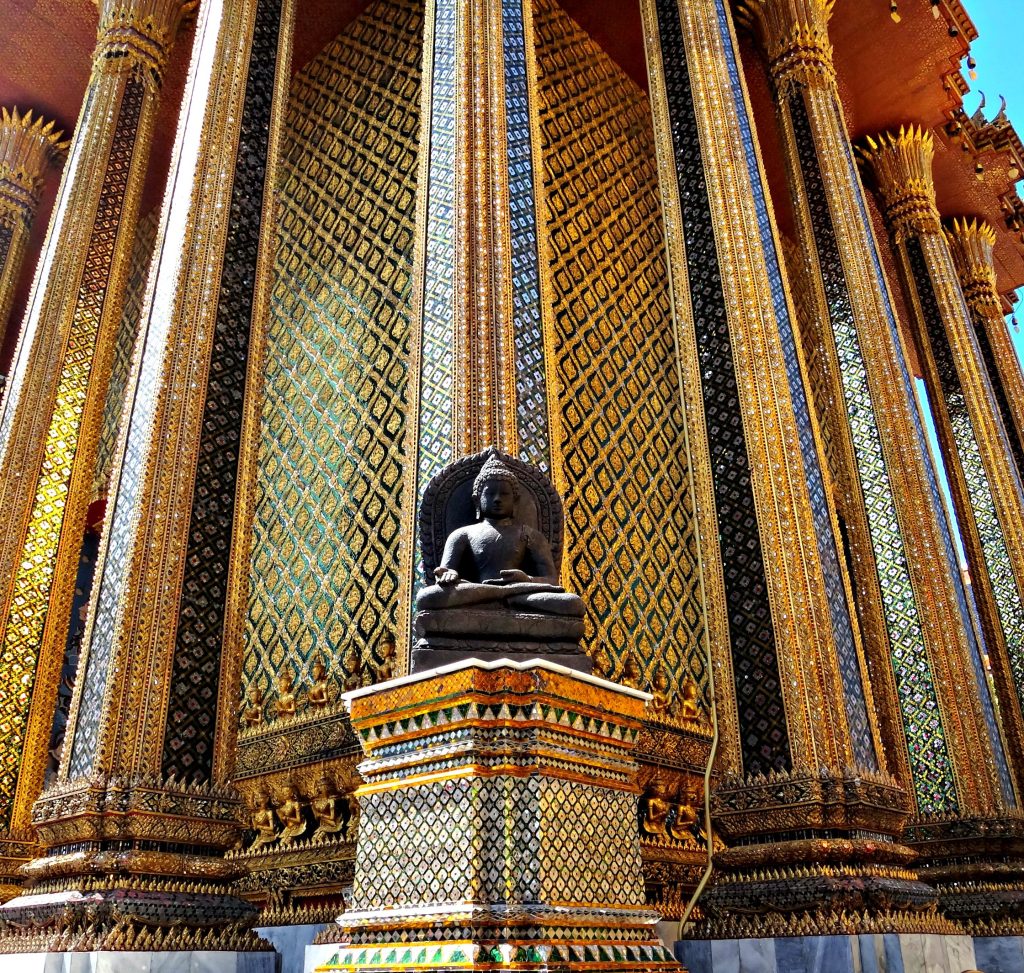
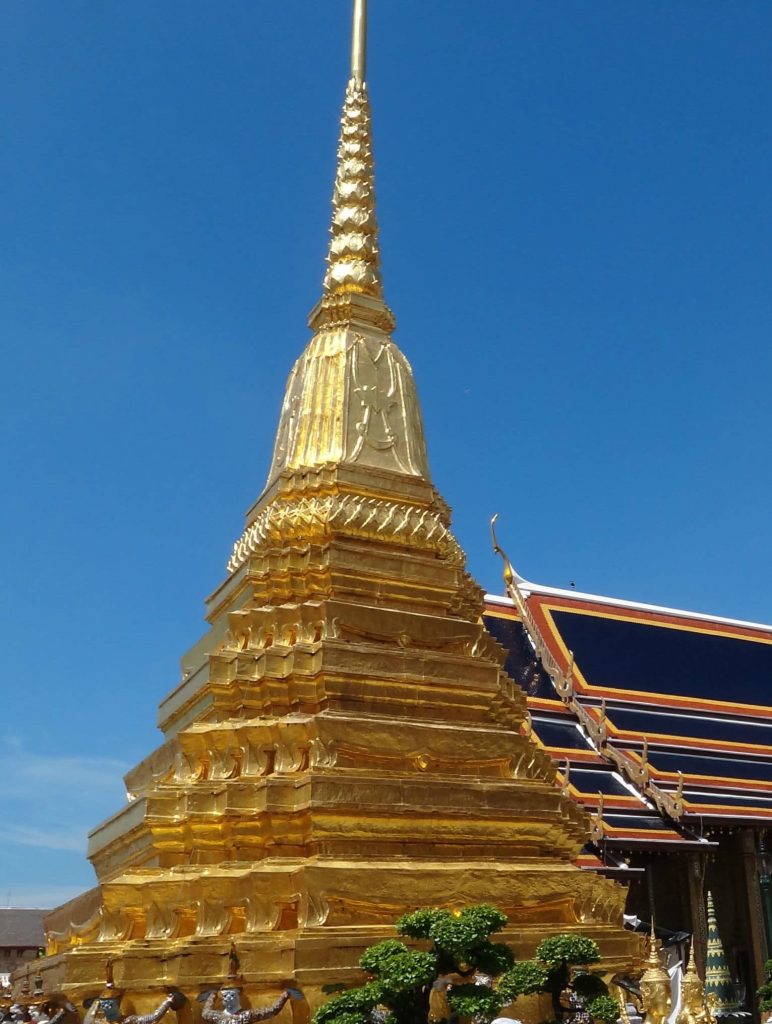
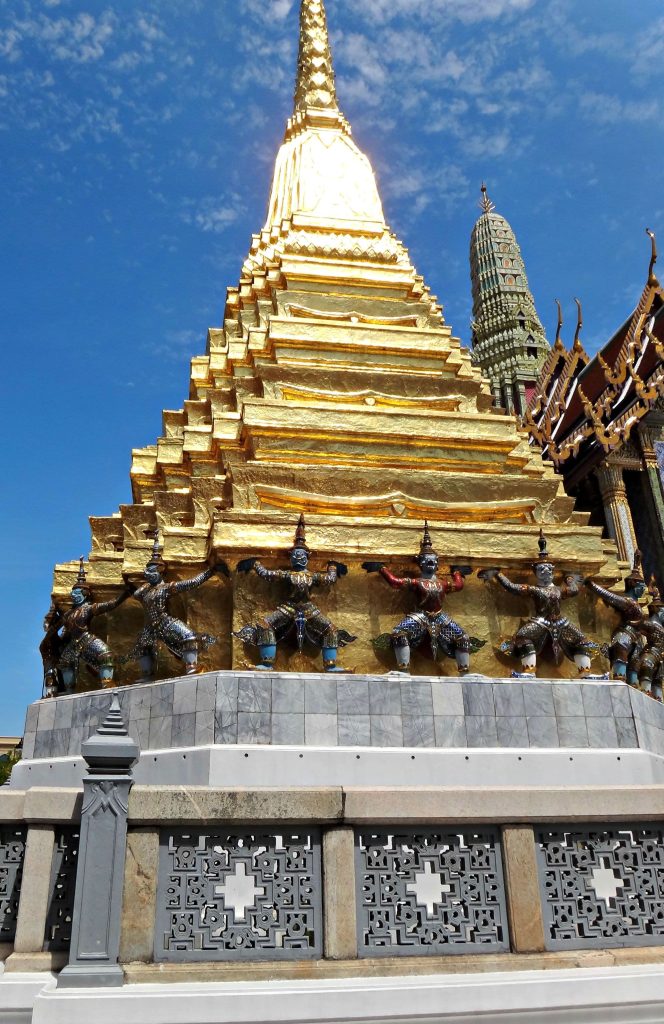
Subsidiary Buildings
This section contains the Scripture library, the mausoleum and crematorial ashes of the Royal Family, Buddha images dedicated to the Kings of Ayuthaya and images dedicated to the present dynasty.
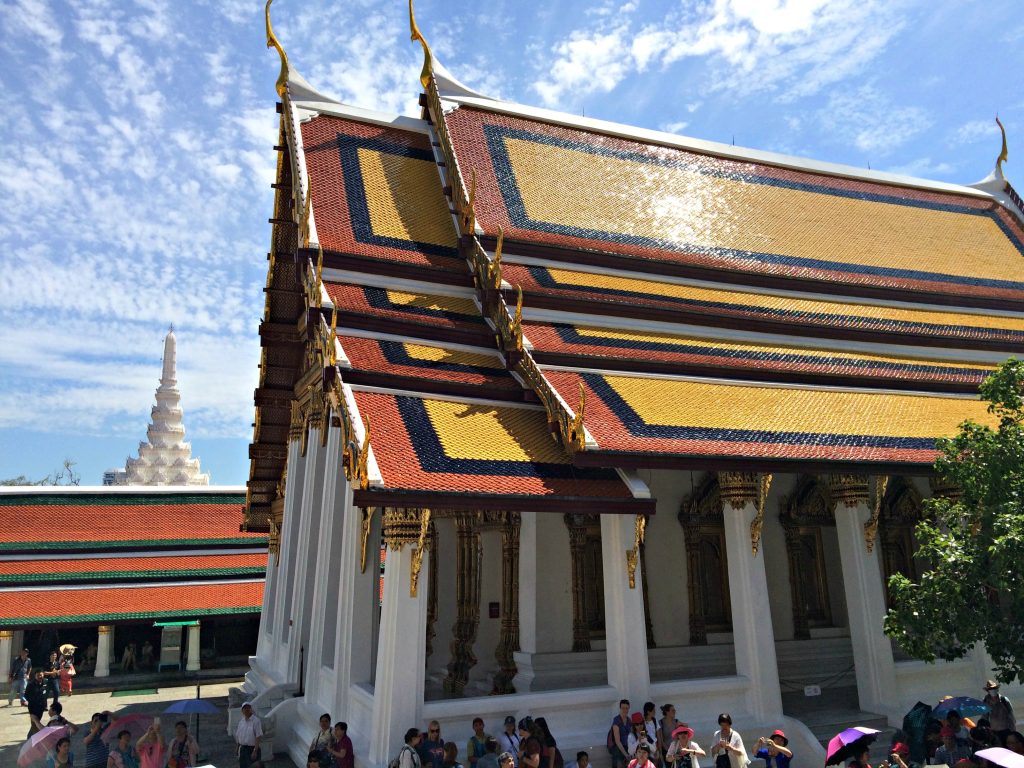
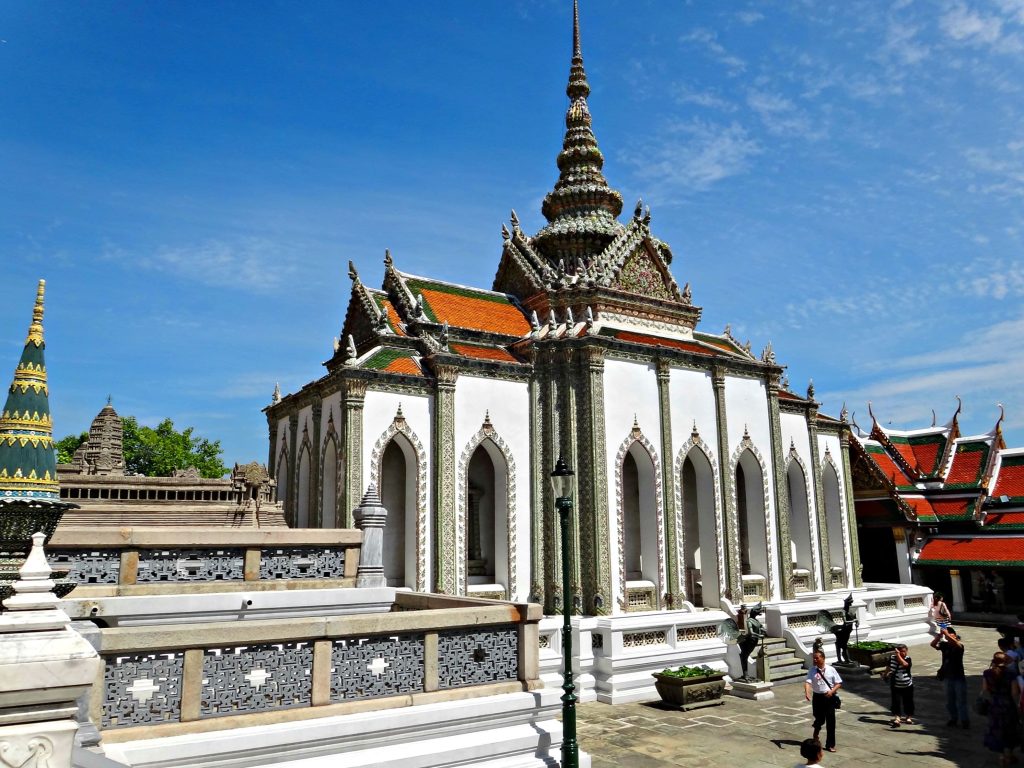
The Chakri Group and Dusit Group are other extraordinary buildings within the palace walls. The Chakri Hall is primarily used for receptions for foreign ambassadors. Dusit Hall (the final picture in this group) is used as the traditional lying-in-state place for the remains of Ayutthaya kings.
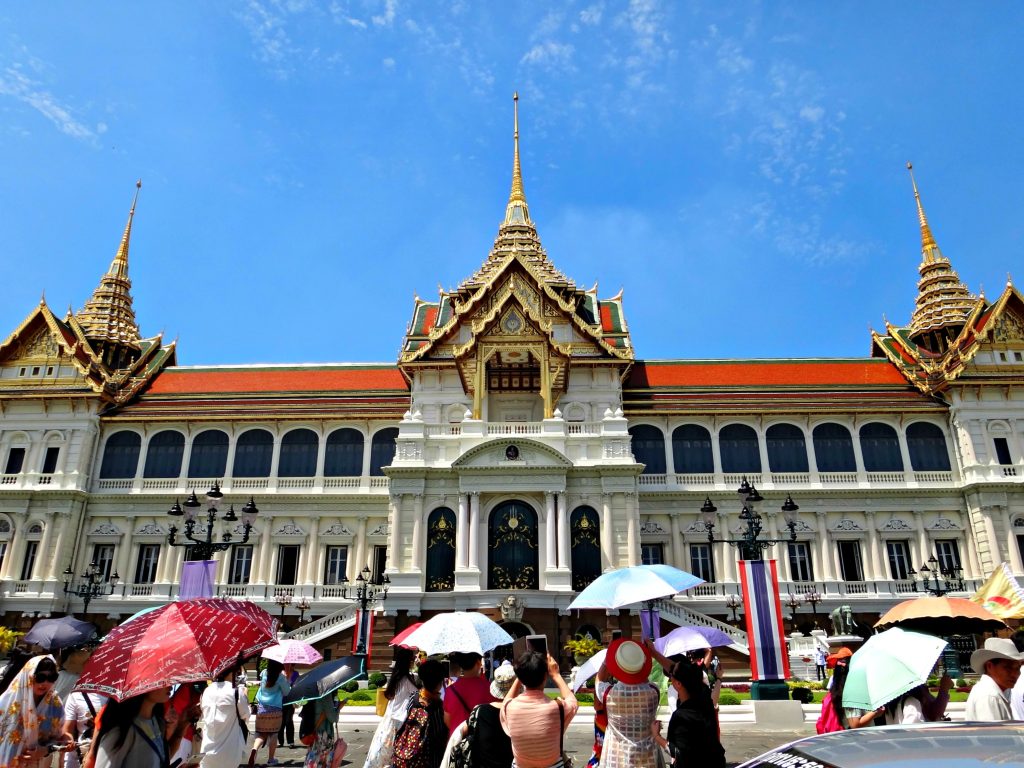
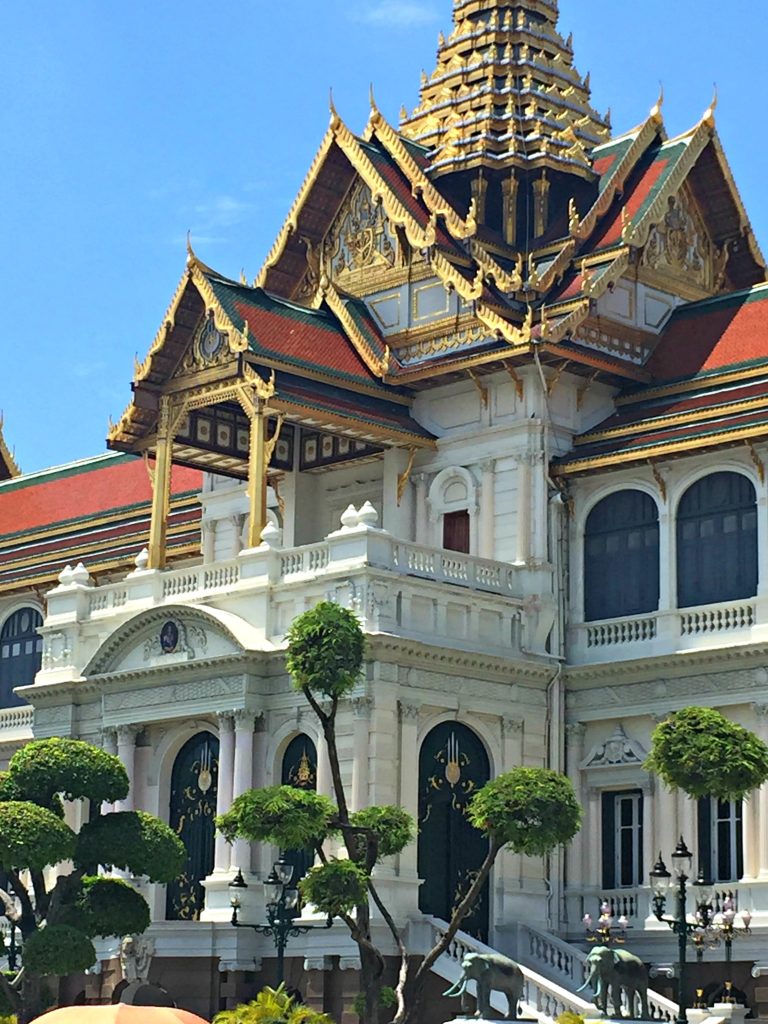
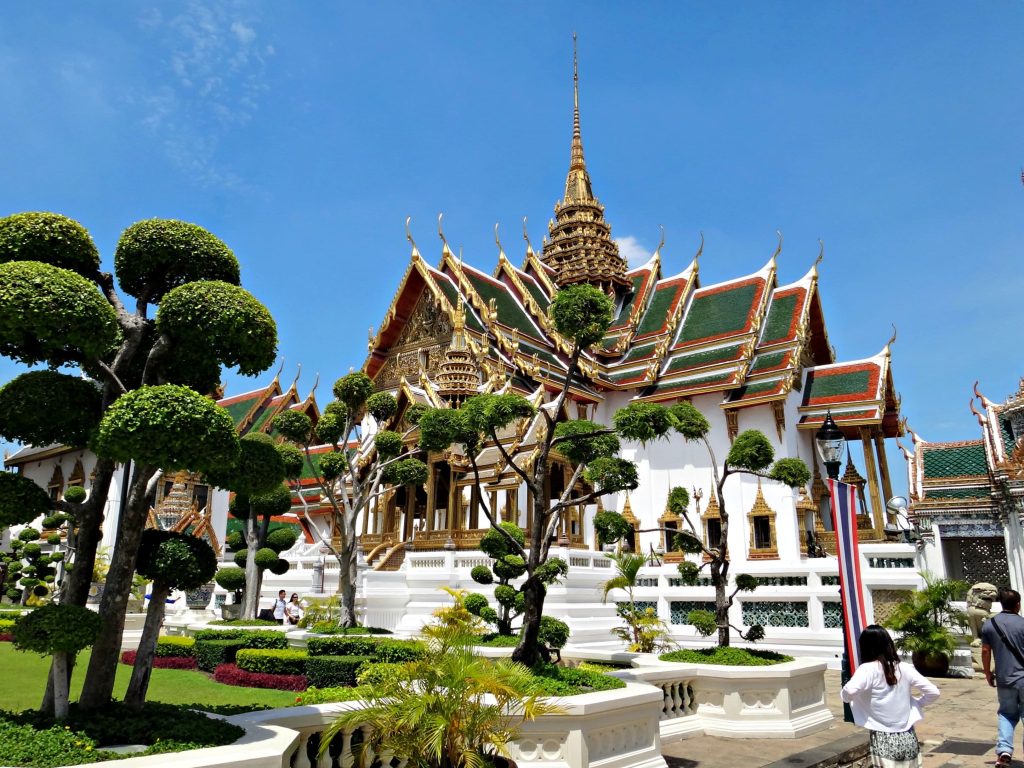
Street Food
There is a variety of street food in Thailand. The carts are everywhere selling everything from fruits and freshly squeezed juices to dried fish and more. It’s hard to know what’s safe and what’s not. For the most part you can tell which ones look relatively safe. I would say the common rules apply. If locals are eating there, it’s probably pretty good. If you see flies or apparent mishandling of food, it’s probably not a good idea. Our guide helped us when we passed carts and wanted to try something.
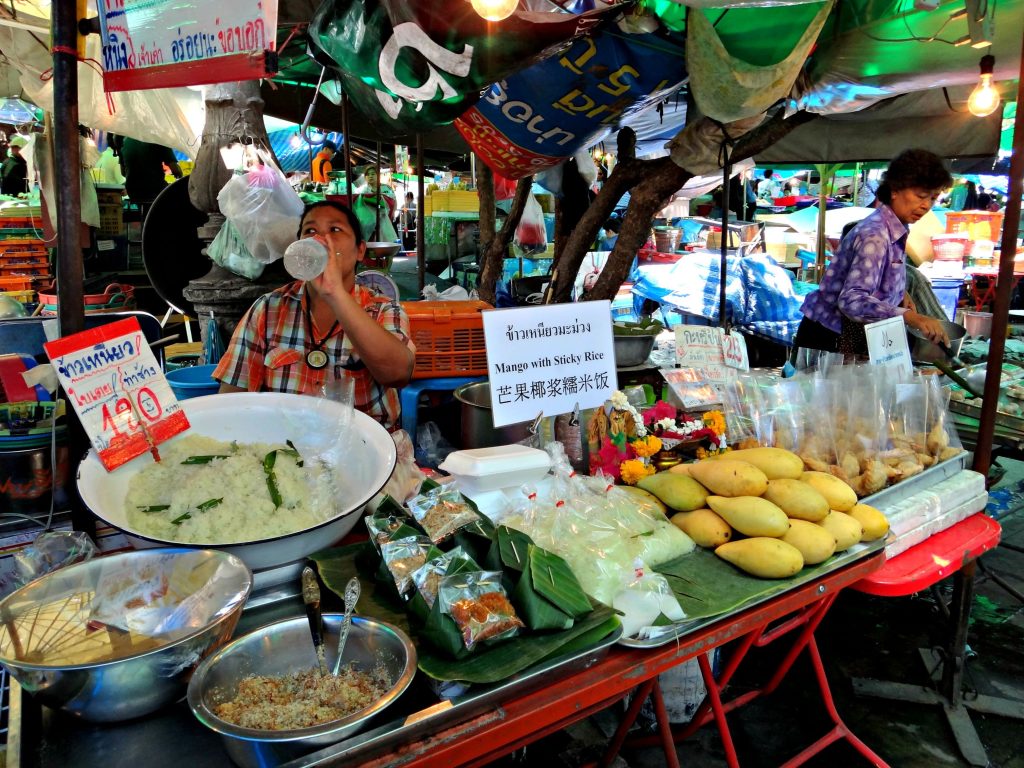
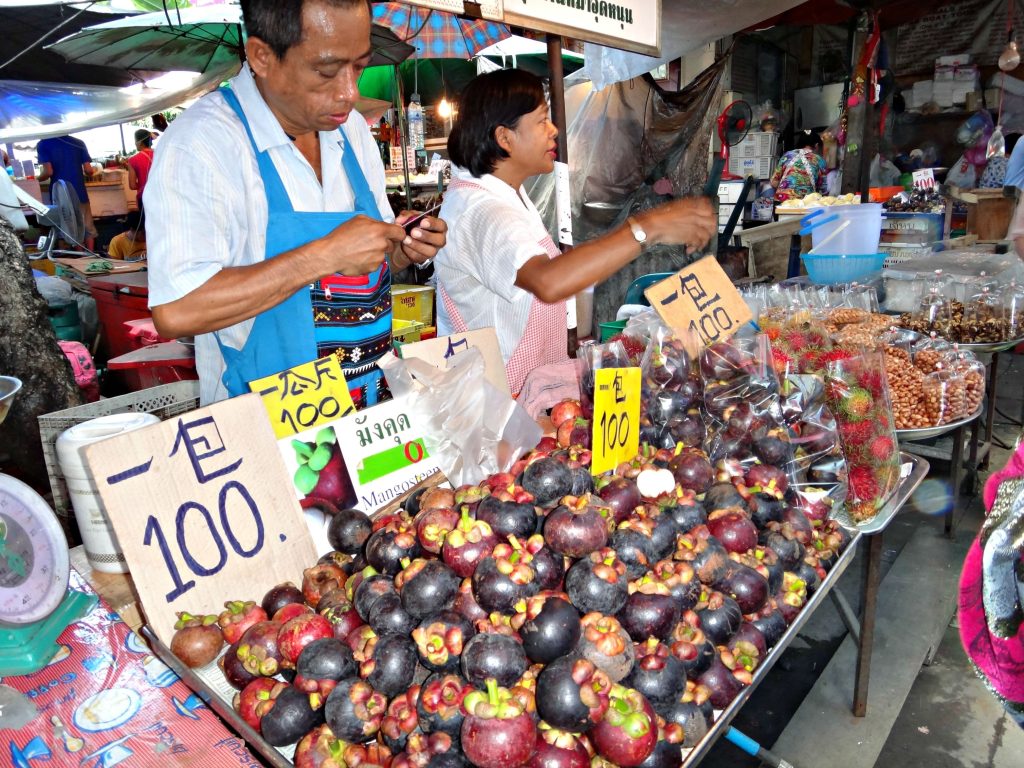
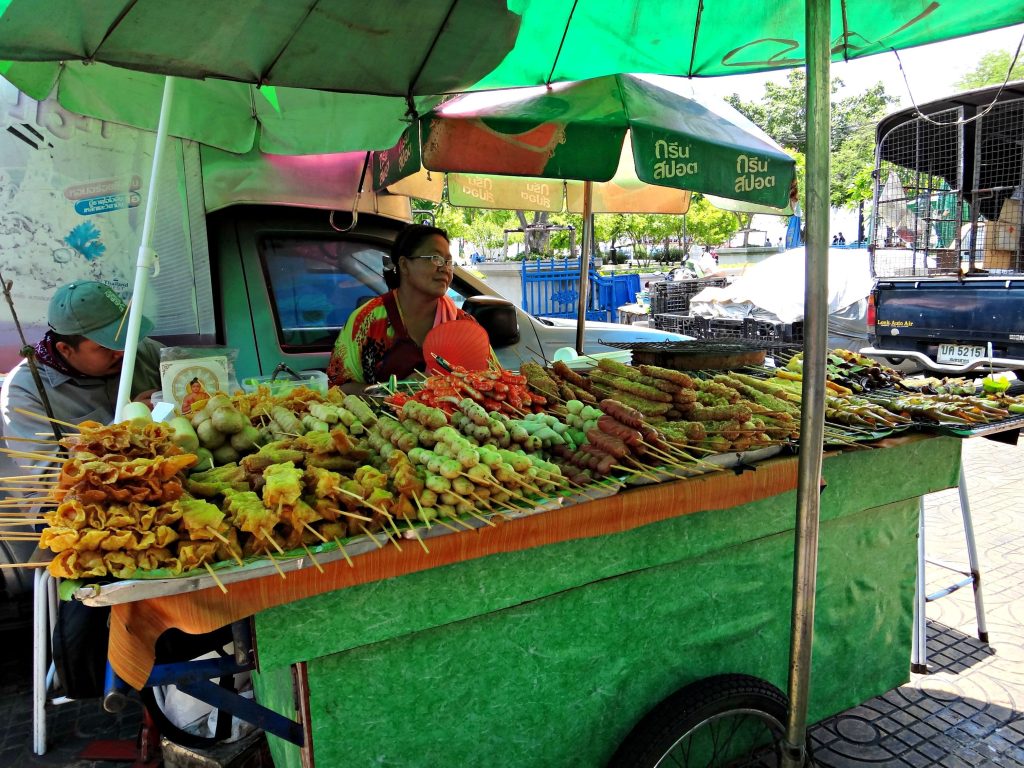
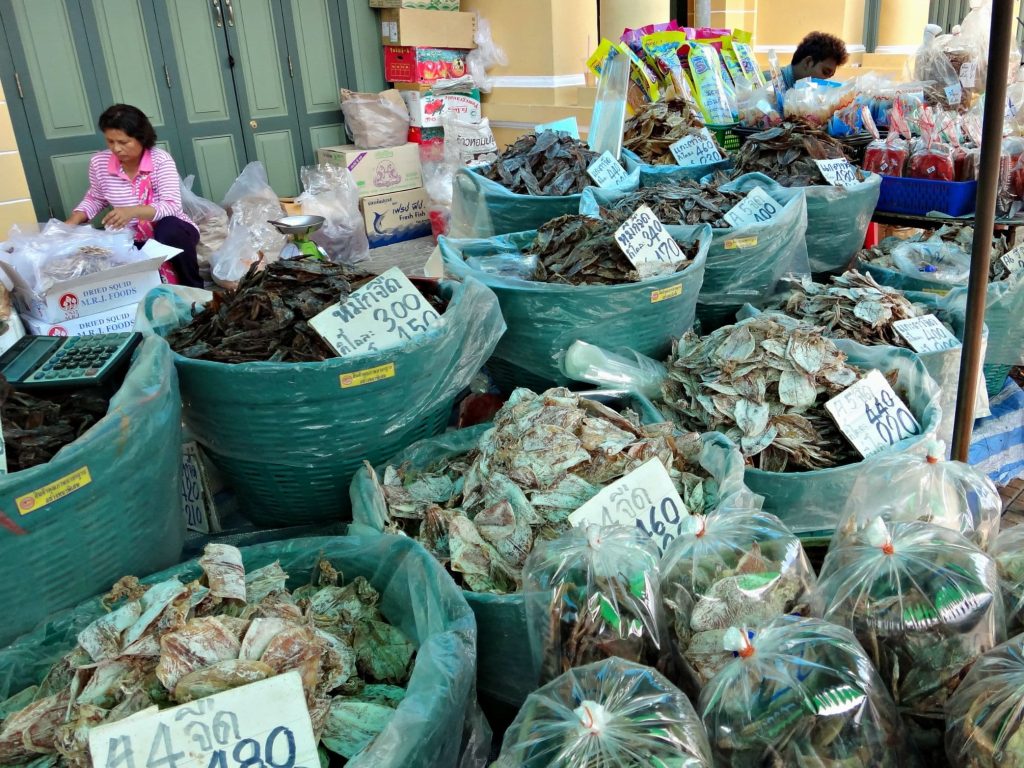
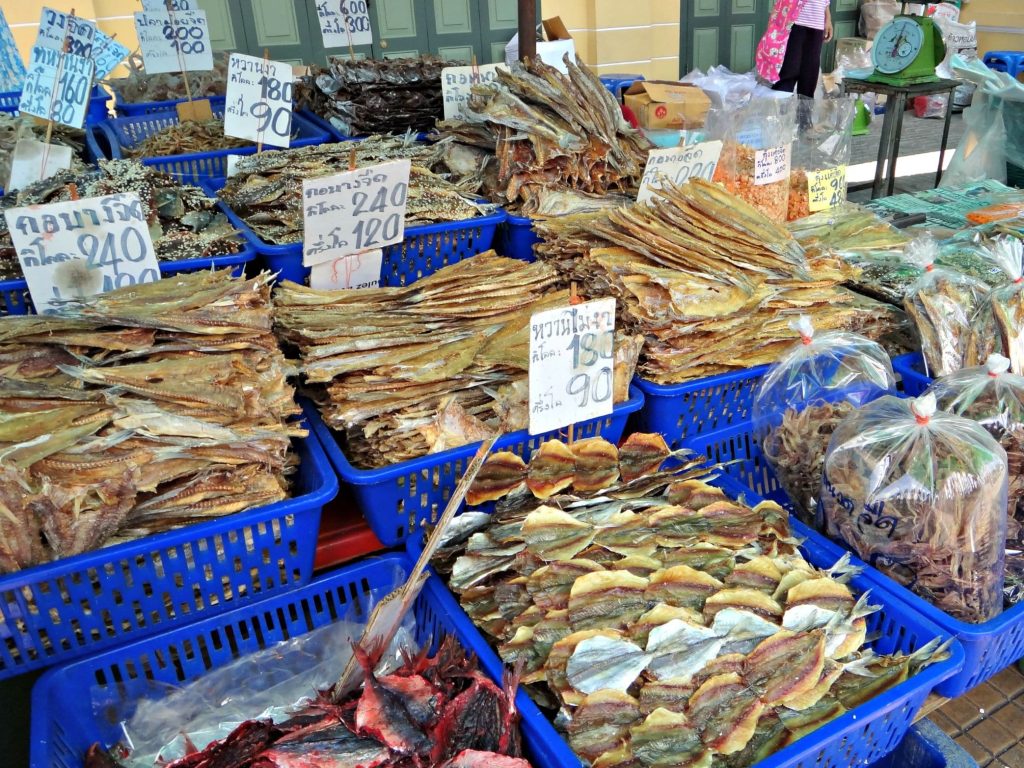
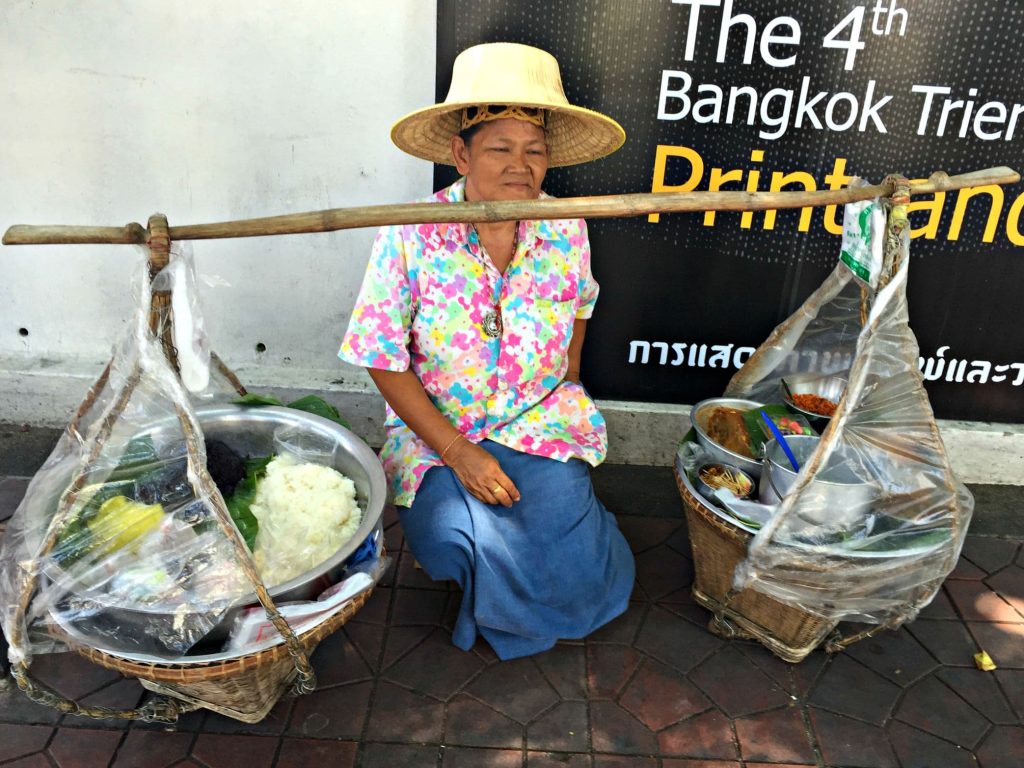
Chatuchak Market
There are many markets in Thailand, but this is the legendary market in Thailand and one of the most notable markets from around the globe. The market is open only on the weekend and is a shopper’s paradise. It is a treasure trove of merchandise, and the process of weeding through cheap junk and hunting for things that are actually of value, as well wheeling and dealing with the vendors, is all part of it. Our guide Jakie did all the talking and dealing on our behalf. Pay extra and take a local guide with you to help you negotiate. As Ralphie says in a Christmas Story, Jakie “could bargain like an Arab trader and was twice a shrewd.” It made all the difference for us having someone there who could quickly exchange money, speak both languages, and haggle with the dealers for us, especially when it came down to buying several items at one stall. We bought several silk and cashmere scarves, small bags, and entire set of flatware for the the same cost as one set at places like Restoration Hardware or Pottery Barn. My biggest suggestion is to Google the market map, plan the sections you know you want to visit, and start there first. We didn’t even scratch the surface of the stalls at this market. It is overwhelming. There is a lot of repetition of items, so that does make it easier for you to scan through the stalls easily. After your first two rows, you get the hang of it, and can easily, visually skim over the stalls and pass by what you know you aren’t interested in. The market includes housewares, furniture, clothes, food, luggage, etc.
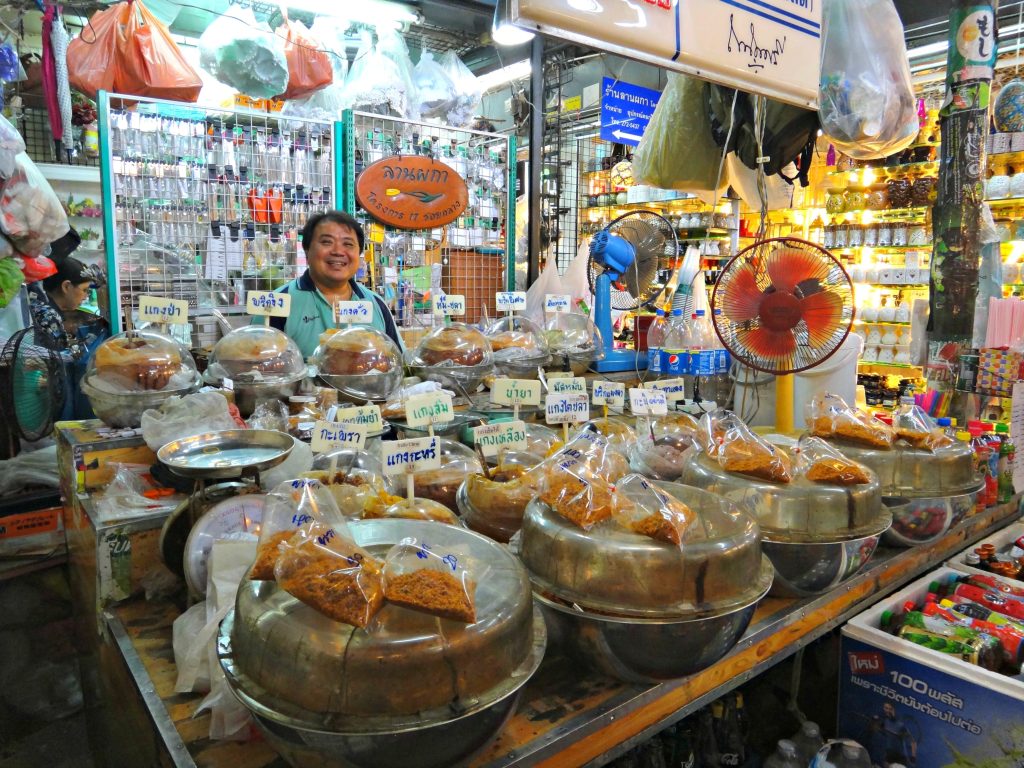
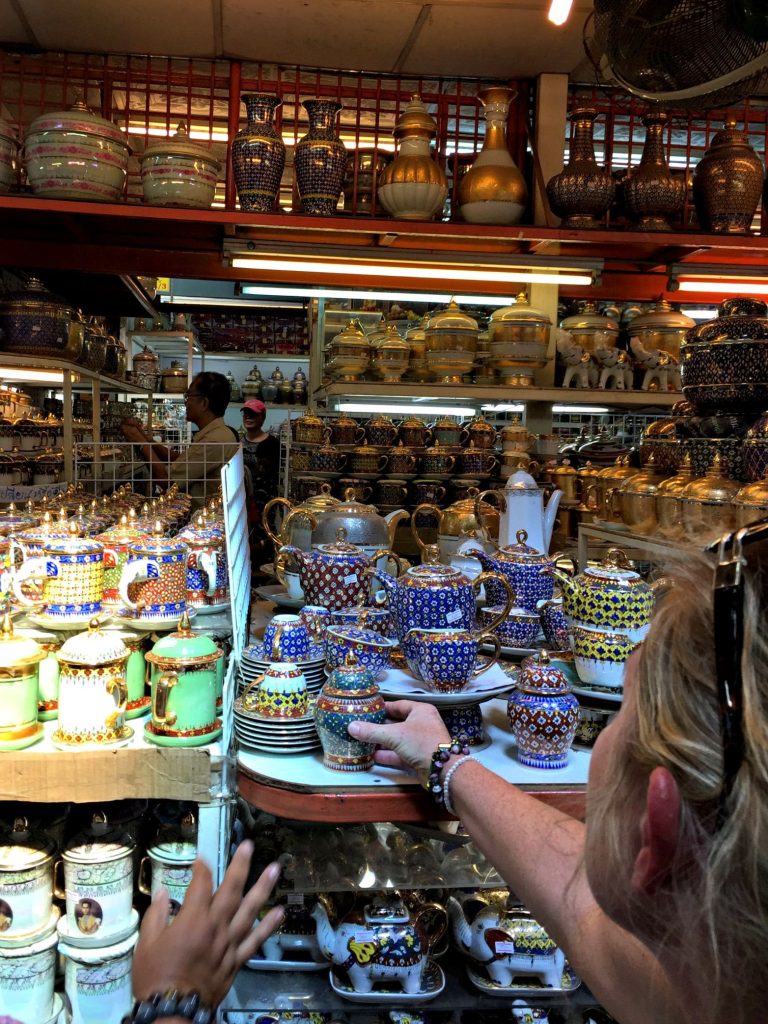
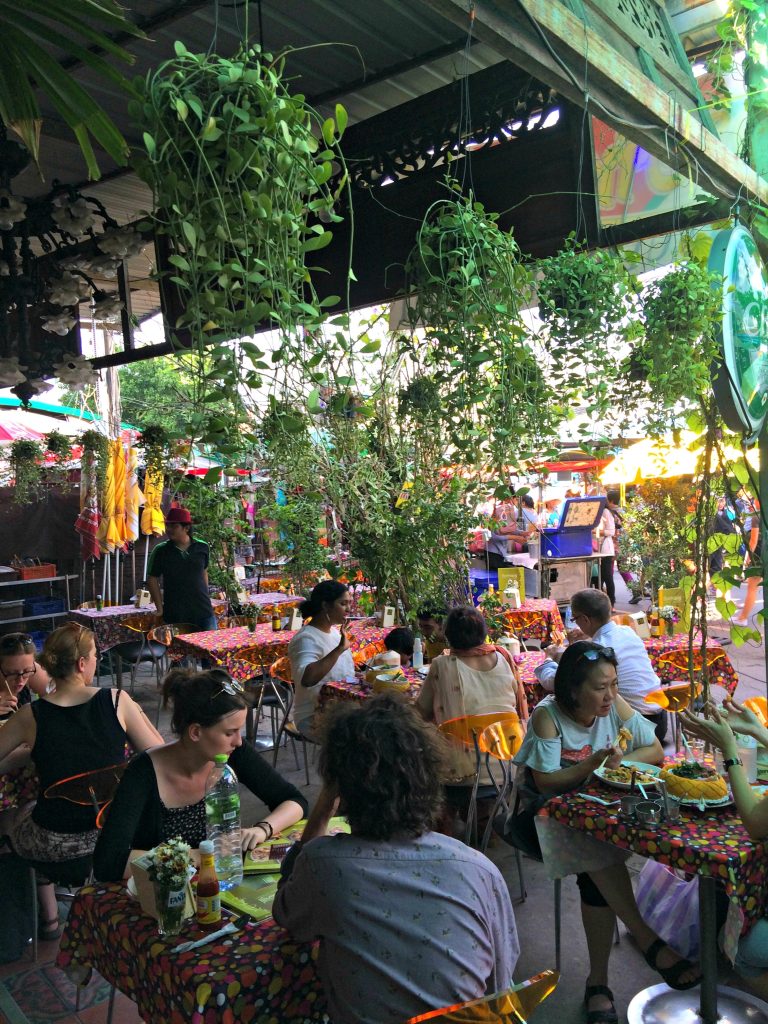
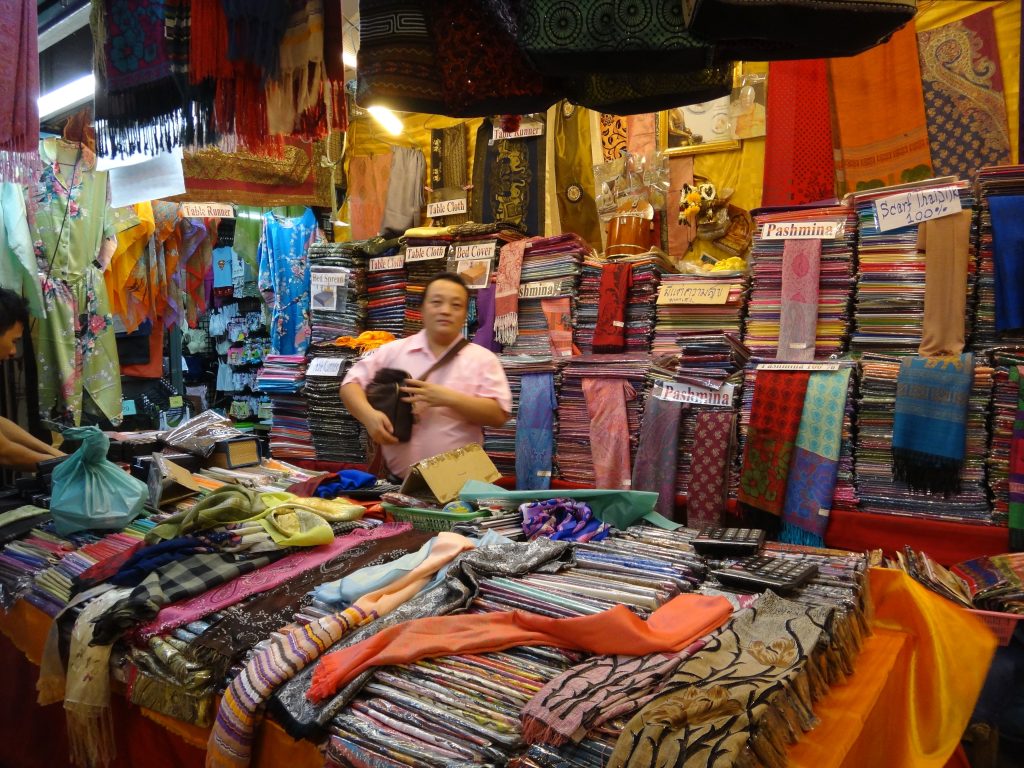
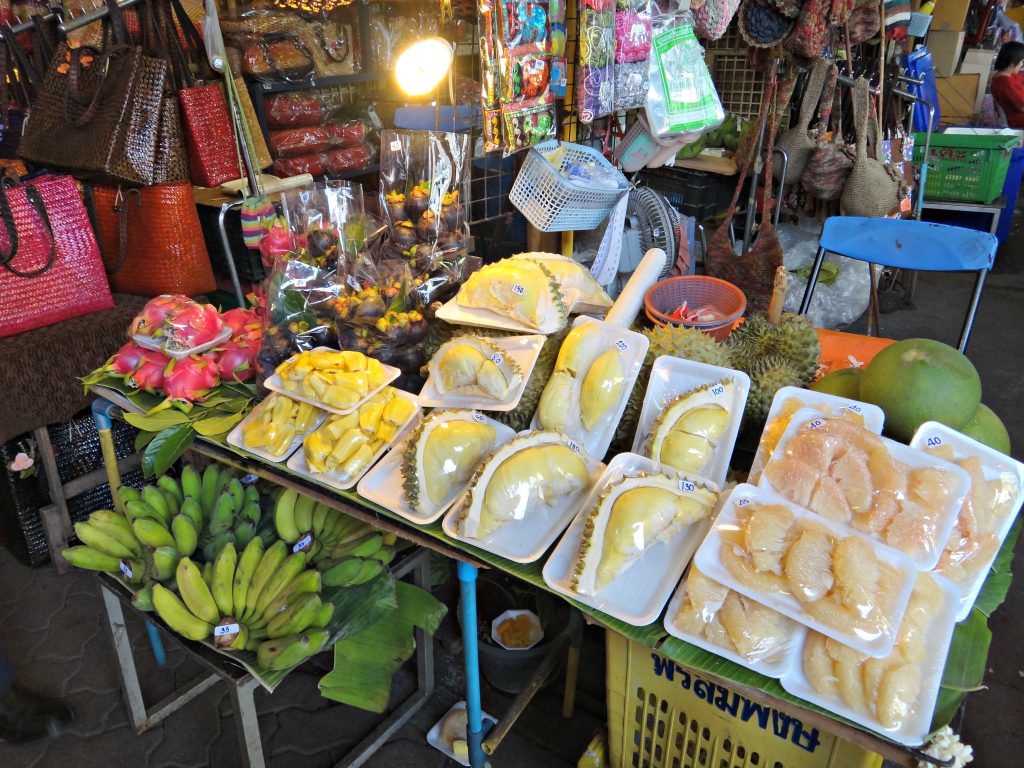
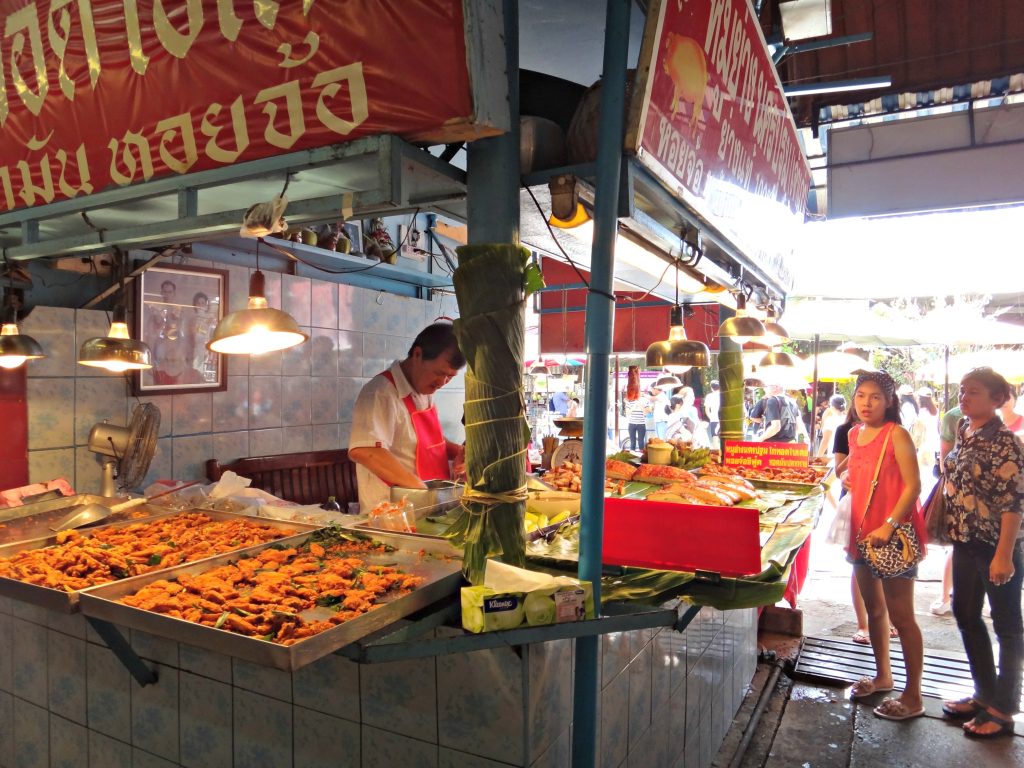
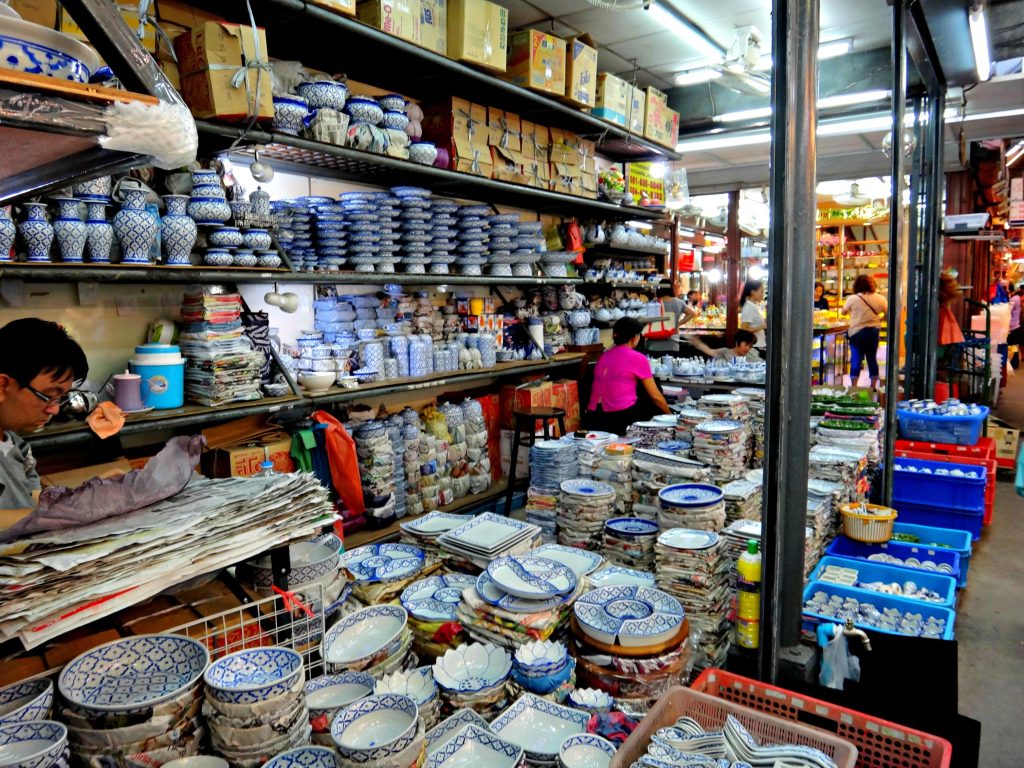
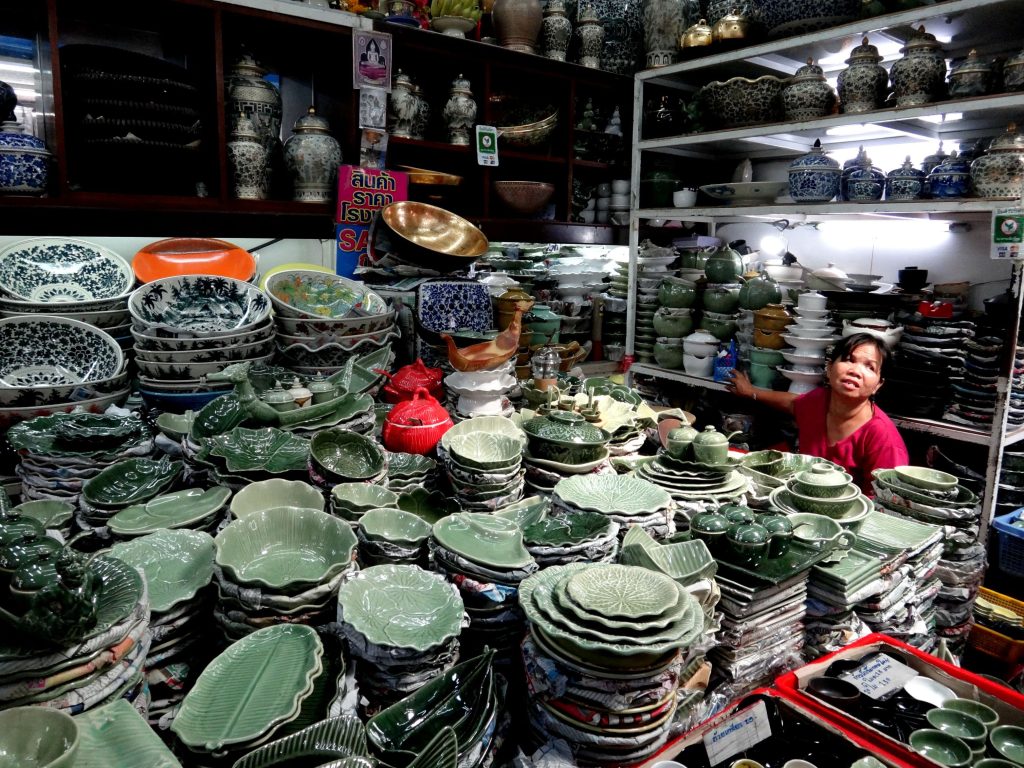
Jim Thompson House
If you love architecture and design, you have to stop by the Jim Thompson House. Jim Thompson was an American Thai silk trader and practicing architect prior to WW II. After serving in the military in Thailand as a US Army officer, Thompson fell in love with the country. Thompson decided to settle in Bangkok and began the process of reviving the silk trade there and put Thailand on the map in the silk industry. He built a traditional Thai house in Bangkok which now serves as a museum and gift shop selling Thompson silks. His silks are sold world wide for interiors and fashion.
Thompson adhered to the most strict customs during the building process. He combined six teak structures that were at least two centuries old that represented the best in Thai architecture. These houses were dismantled and brought to the current site from the old capitol, Autthaya. The houses were elevated a full story off the ground to prevent flooding during the rainy season and also allow for cooling. The roof tiles were fired in Authaya using a centuries old process, and the paint on the exterior is a preservative common in Thai construction. The traditional religious rituals were followed during the construction of the house. The house is built completely without nails and the steep roof style allows hot air to rise and keep the house cool. Also common in Thai architecture are raised thresholds in doorways. The traditional Thai belief and superstition is the raised thresholds prevent evil spirits from entering the house at night but it also serves a functional purpose. Many Thai houses are built on rivers and canals. The raised thresholds keep babies from falling out into the river. Another custom I love that Thai people practice is not wearing shoes in the house. You must take off your shoes when entering a Thai house, and even though the Jim Thompson house is a public museum, you must remove your shoes before entering.
Jim Thompson disappeared in Malaysia while on holiday in 1967. Not a single valid clue has turned up in his disappearance. The house, the gardens, the antiques and art, stand as a primary example of traditional Thai living.
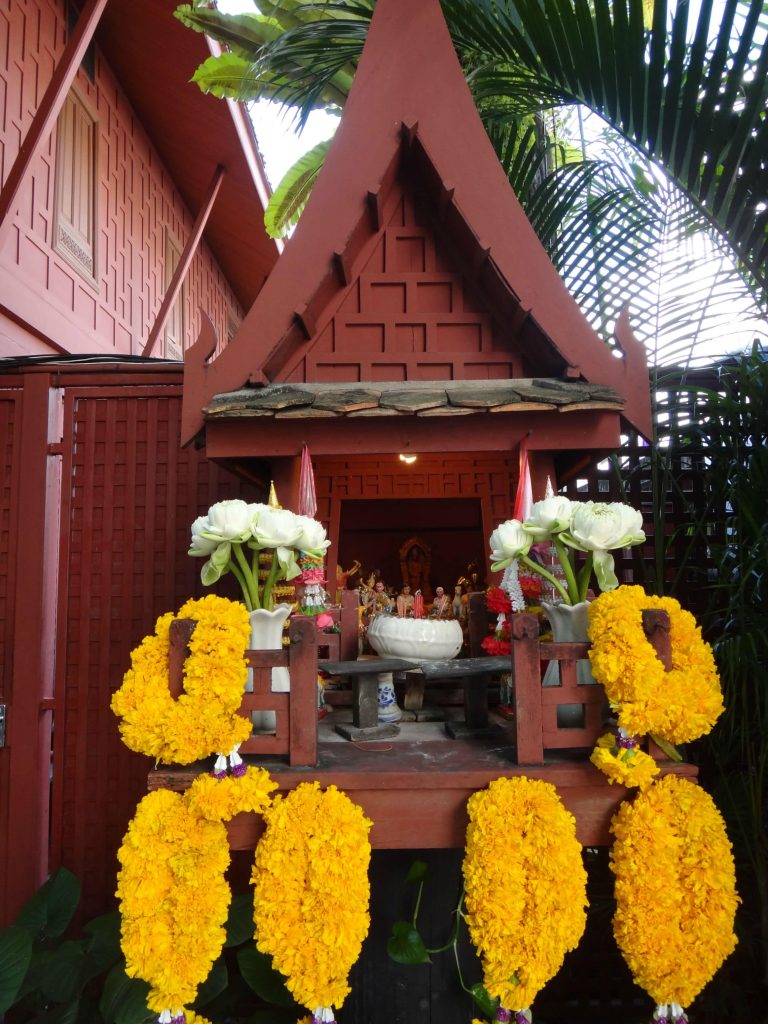
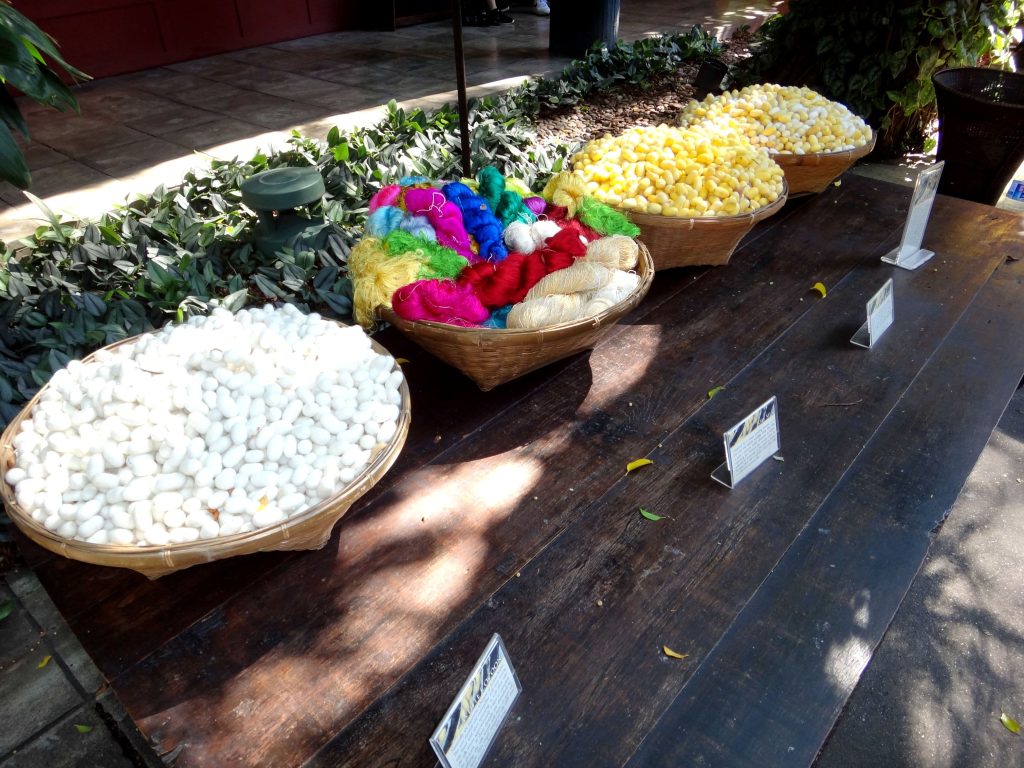
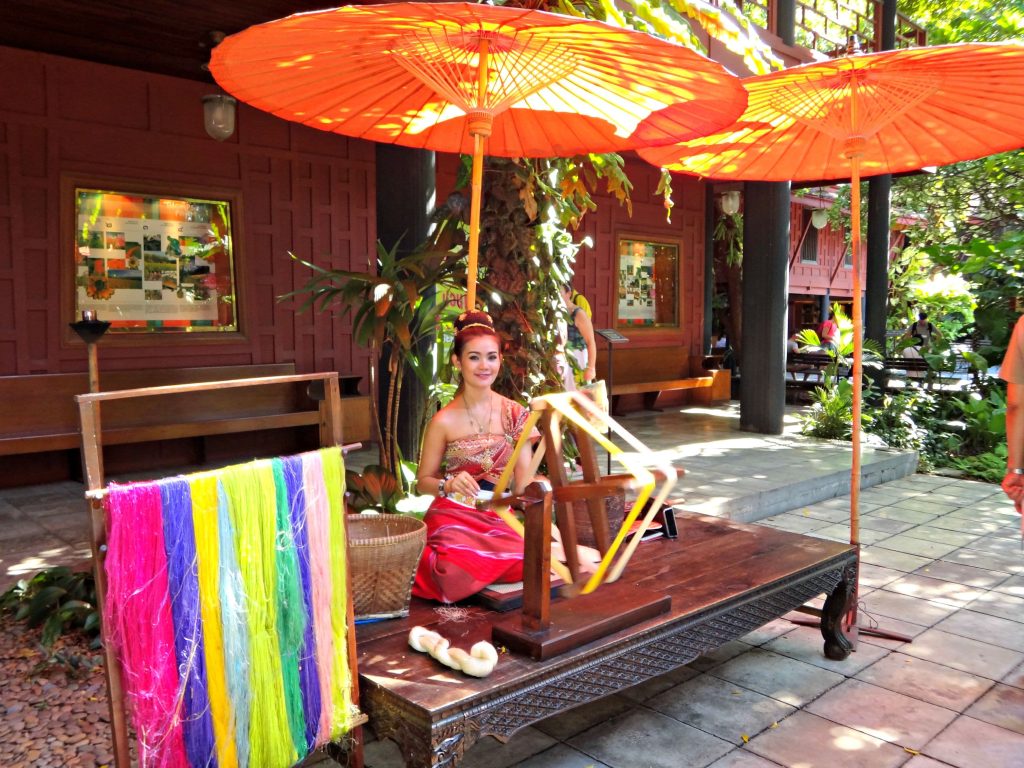
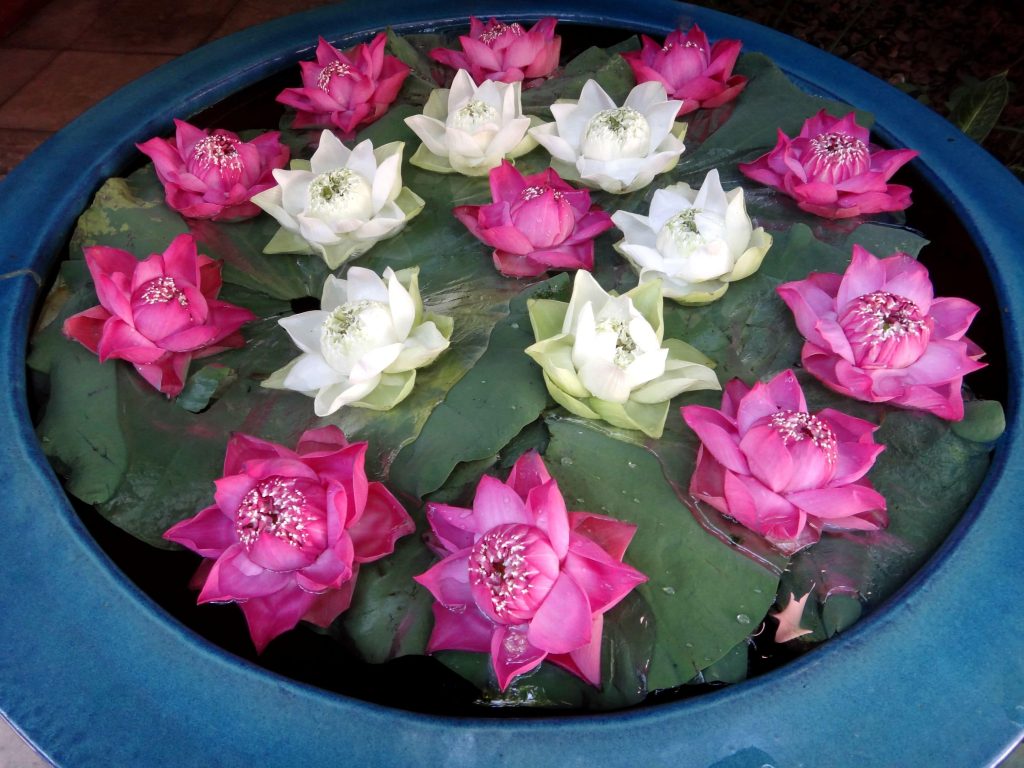
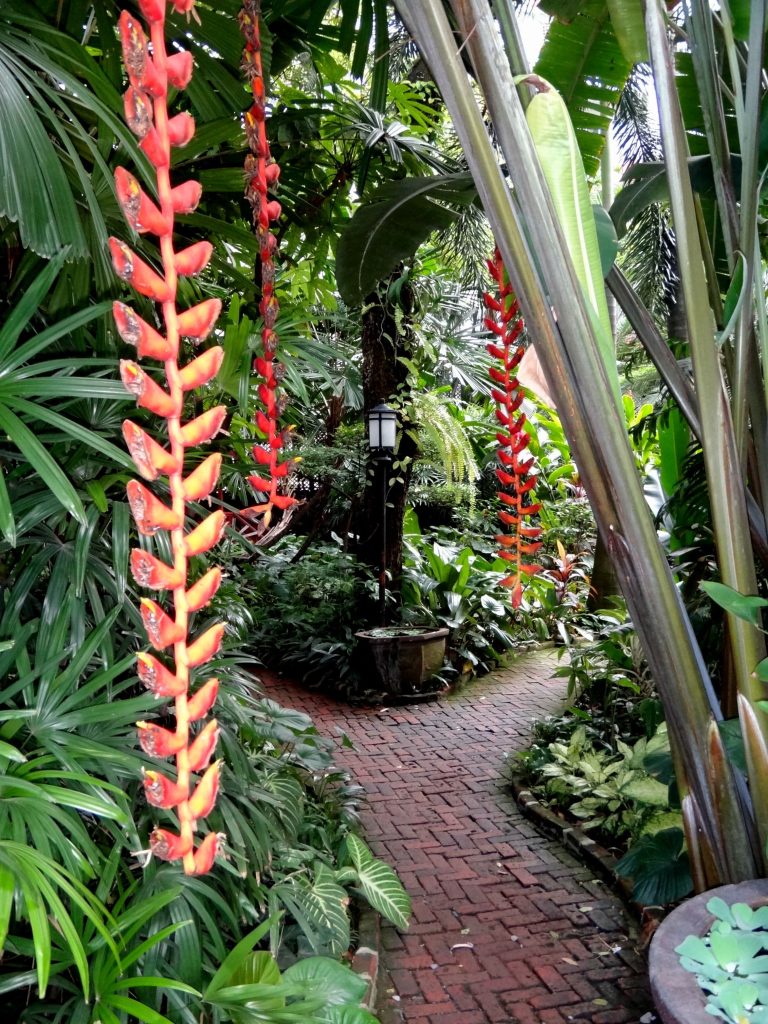
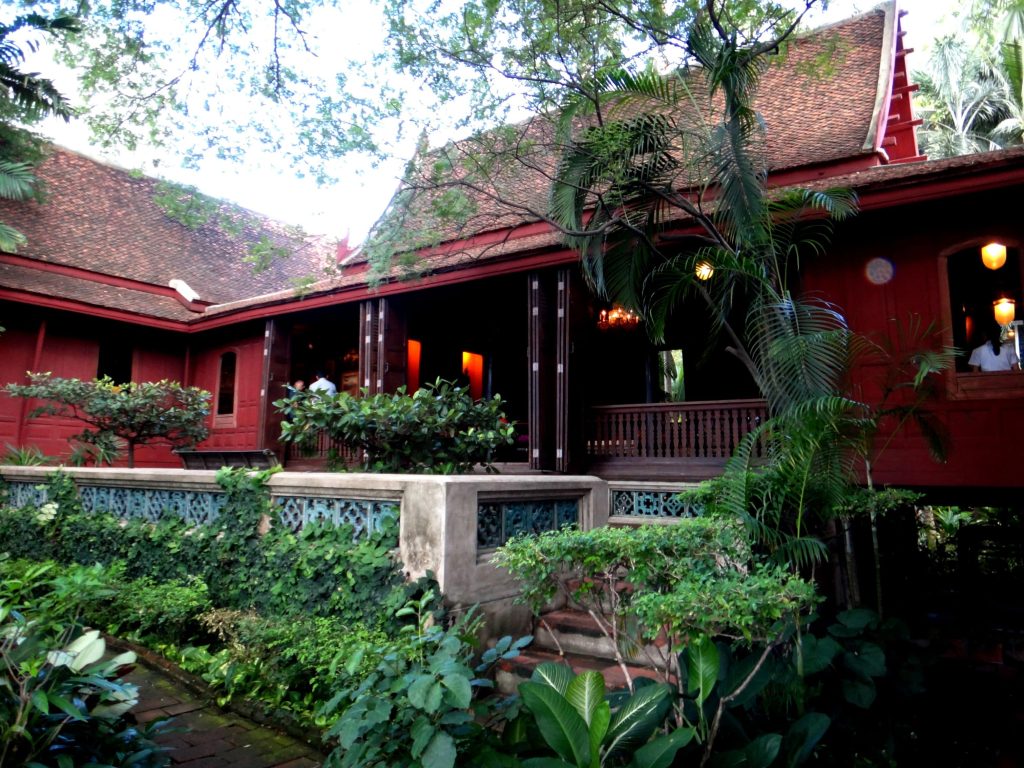
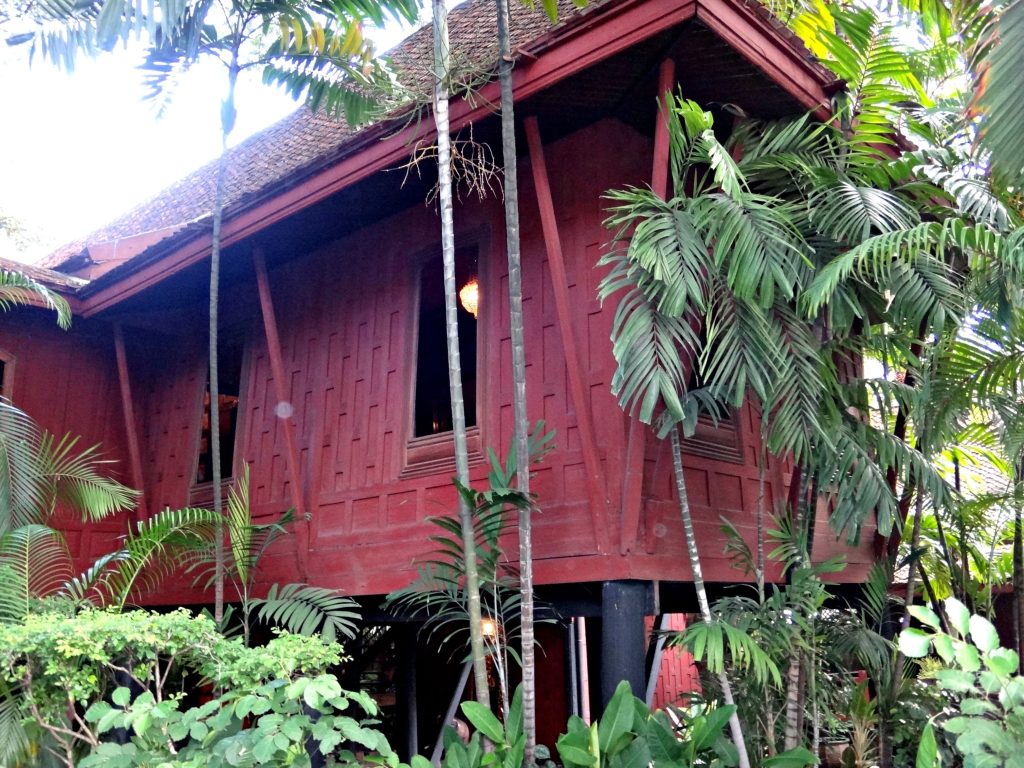
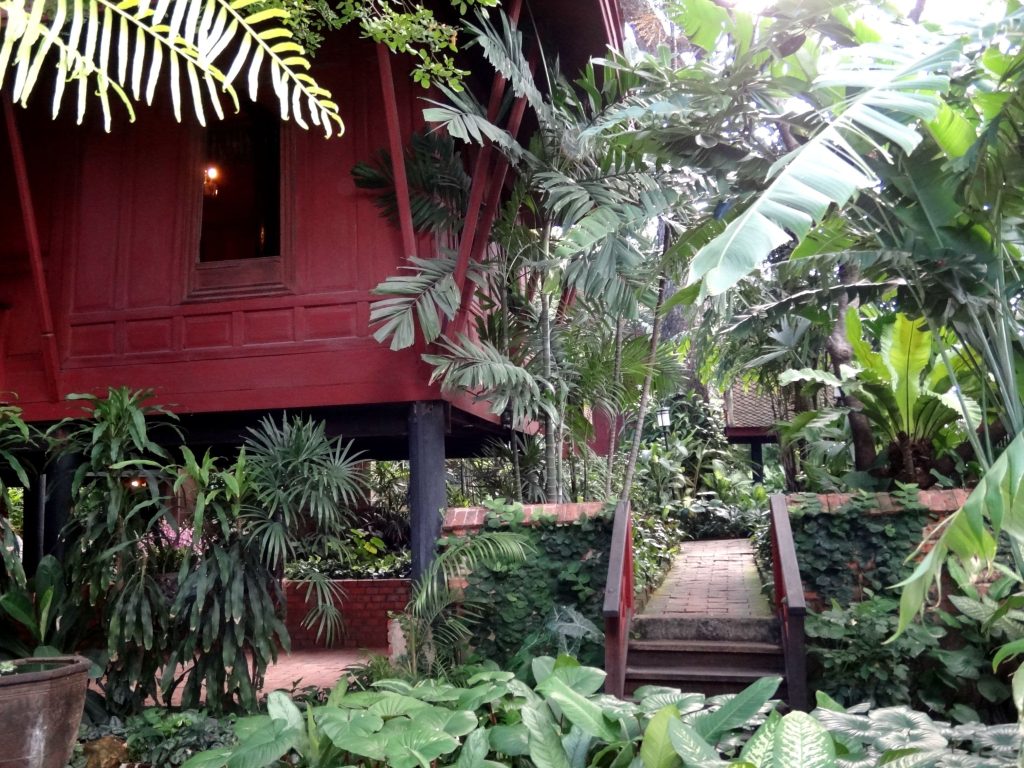
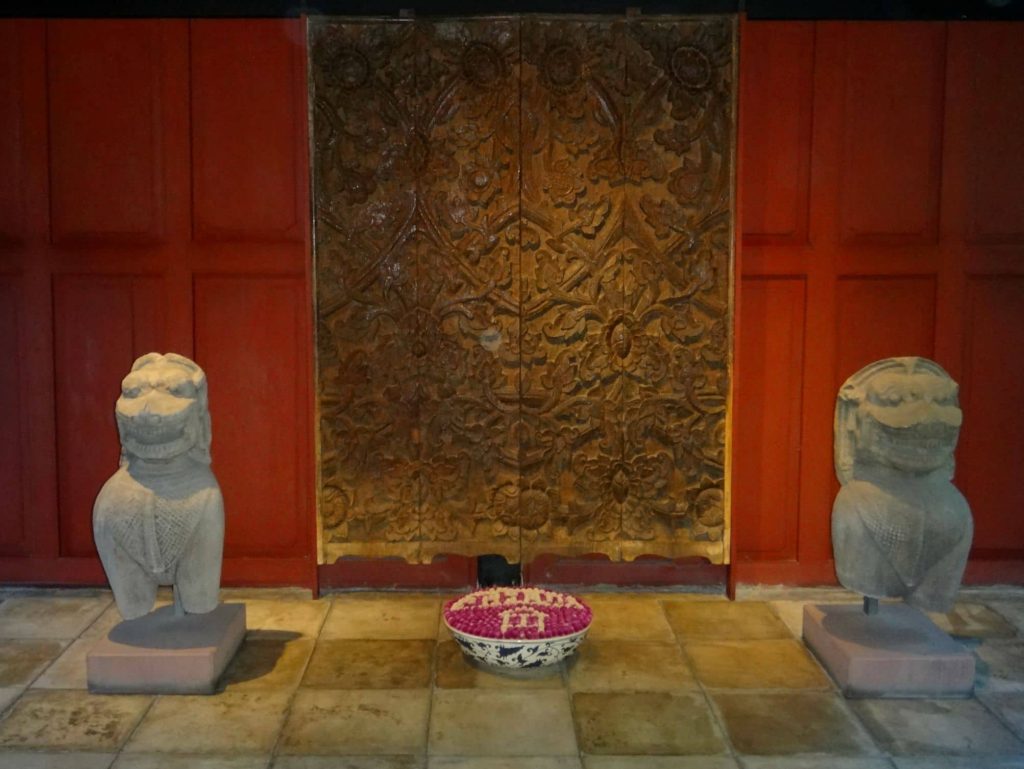
Next up on the blog about Thailand: Ayutthaya, Sirocco and Wat Pho.
A little tuk-tuk illustration I did based on a graphic from our travel documents. <3
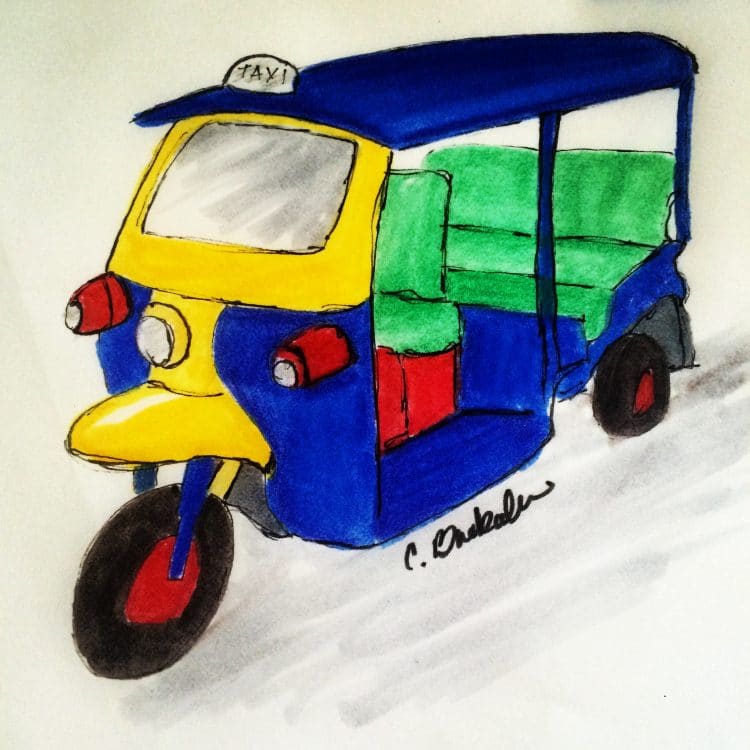
xo,
Cassandra


